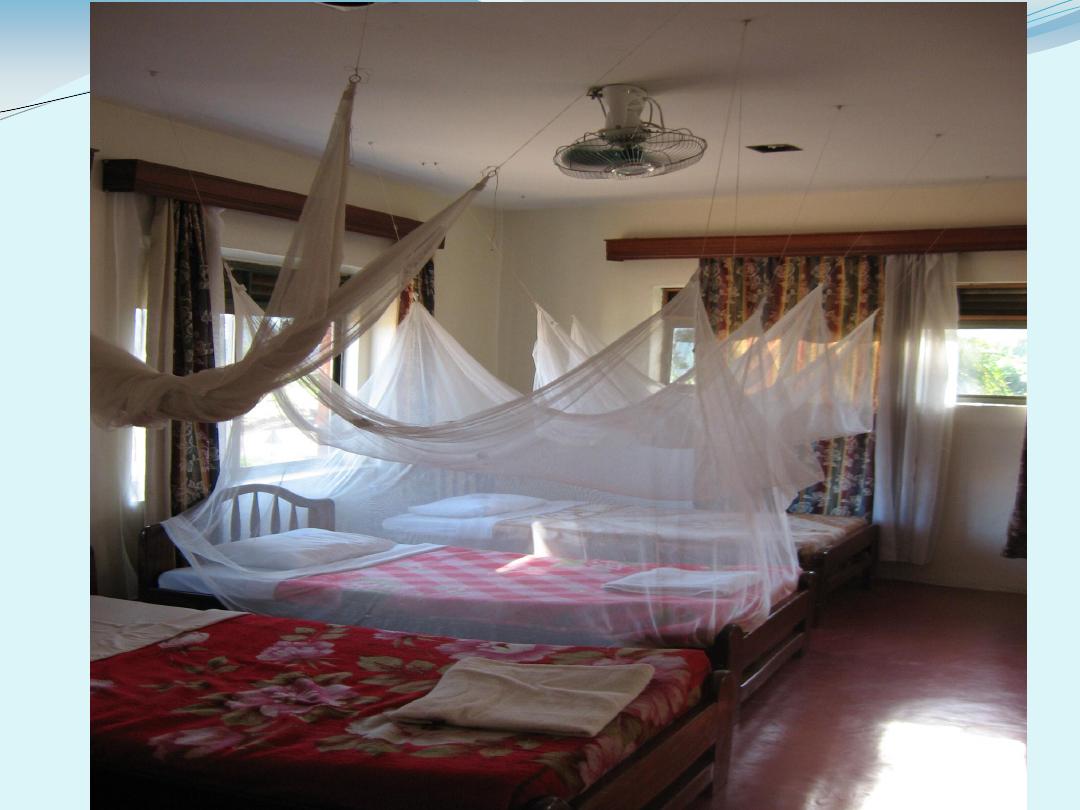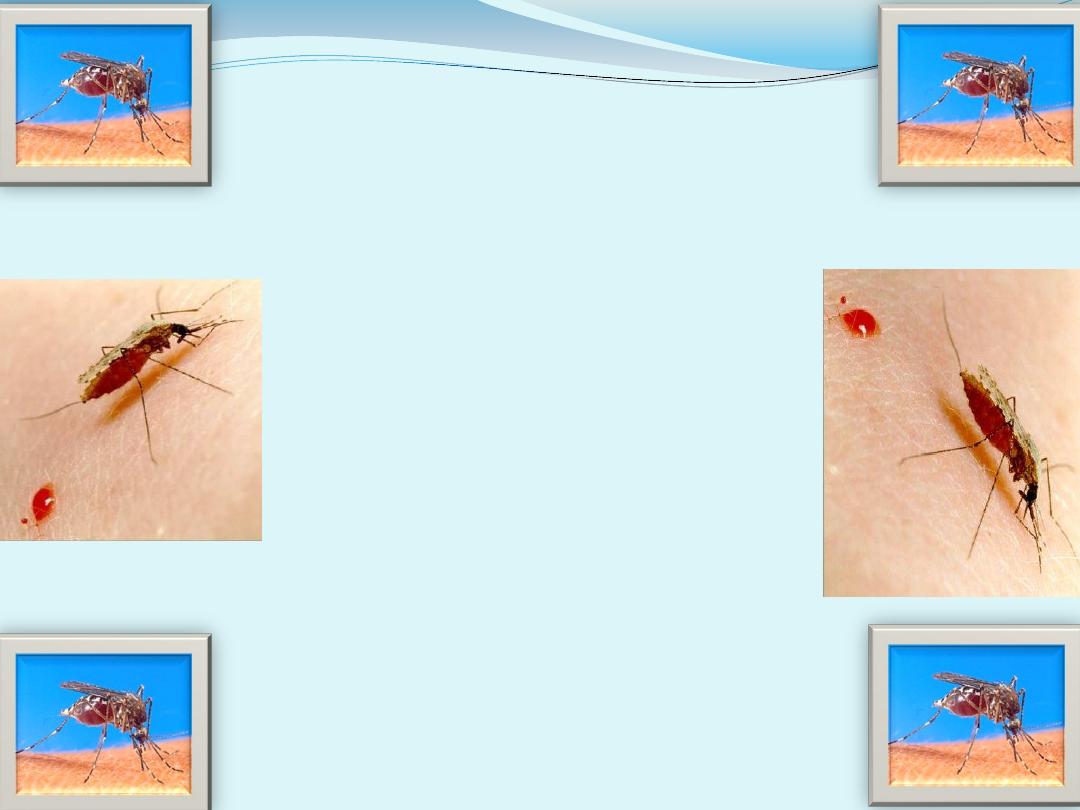
Malaria
Life cycle
Malarial species
Pathogenesis
Causes of Anemia
Clinical Picture
Complications
Lab. Diagnosis
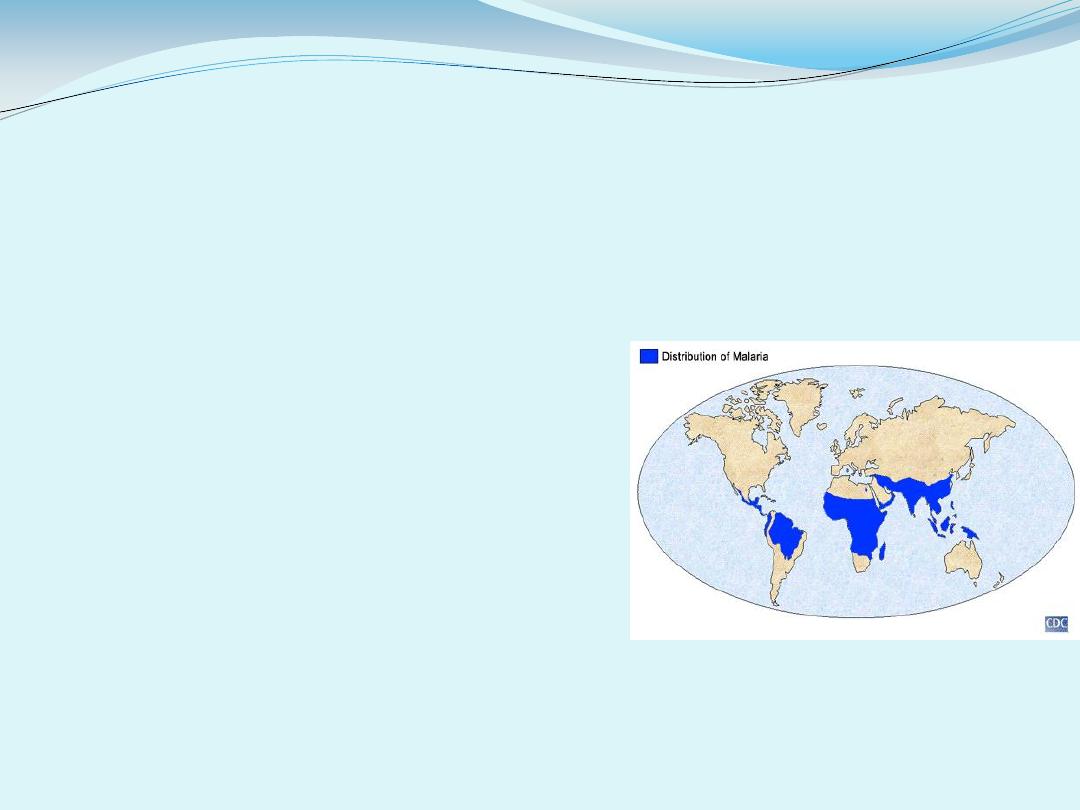
Malaria “Mal-air”
It is a world wide distribution disease acute or chronic
characterized by
fever ,anemia & spleenomegaly
occurs where
anopheles mosquito are present & caused by genus plasmodium
,which is host specific
In IRAQ it is found significantly in the north part of IRAQ
Animal kingdom
sub kingdom : protozoa
sub phylum : Apicomplexa
class : sporozoea
genus : plasmodium
41%
of the world's population live in areas where malaria is
transmitted .

A French army doctor in
of malaria patients
and proposed for the first time
that a protozoan caused
disease
It was discovered
more than 100 years ago
Charles Louis Alphonse Laveran
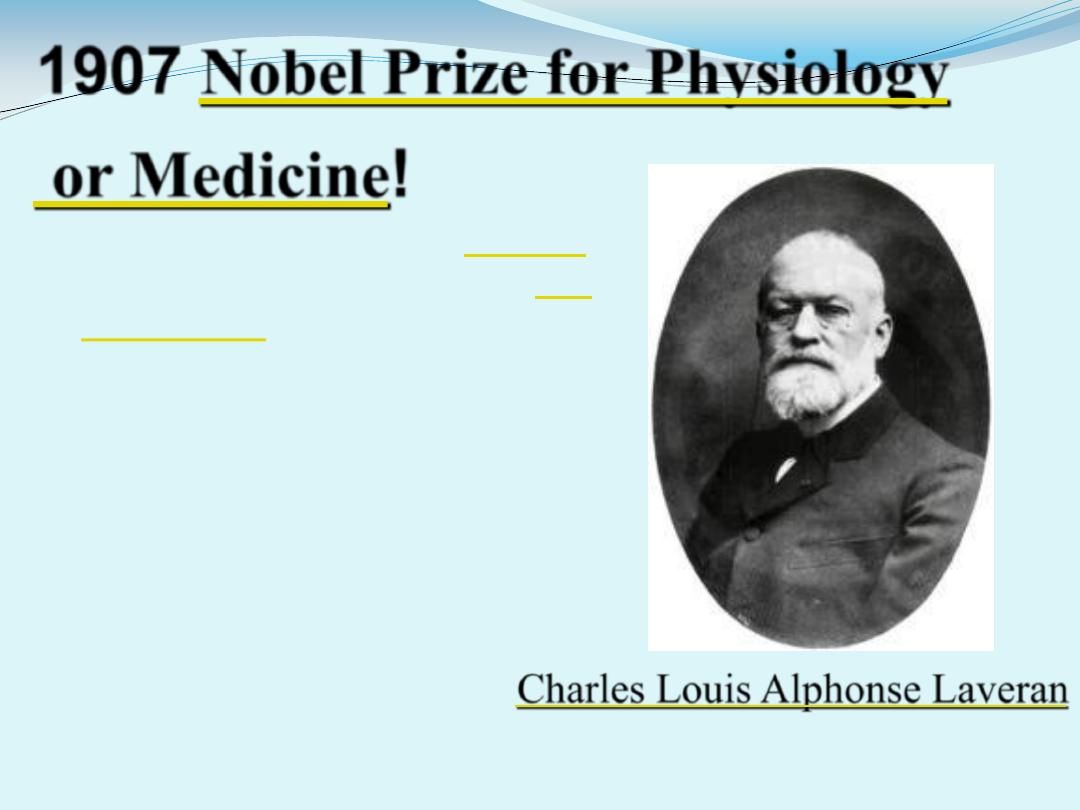
French army doctor in
of malaria patients
and proposed for the first time
that a protozoan caused
disease
Charles Louis Alphonse Laveran

Around 300-500 million clinical cases of malaria are
reported every year, of which more than a million die of
severe and complicated cases of malaria.
Malaria ranks third among the major infectious diseases in
causing deaths after HIV , pneumococcal acute respiratory
infections and tuberculosis, then malaria.
Although malaria has been widely eradicated in many
parts of the world, the global number of cases continues to
rise. The most important reason for this alarming situation
is the rapid spread of malaria parasites that are resistant to
anti malarial drugs
.
Malaria
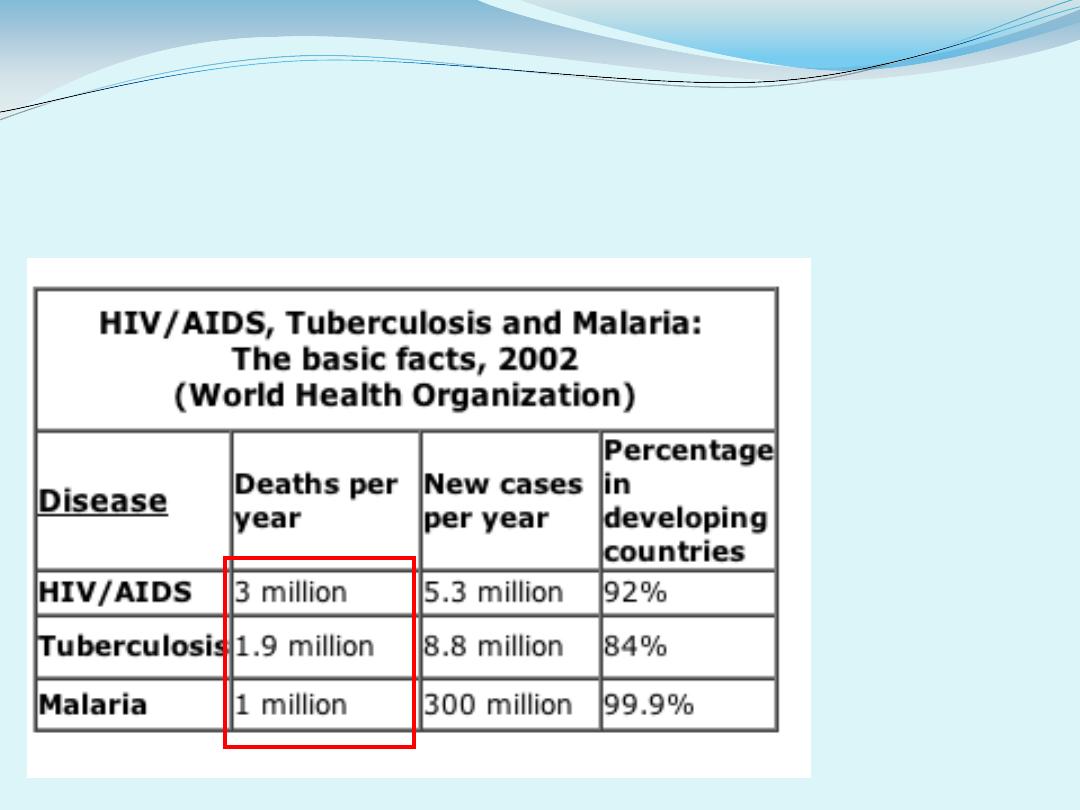
Leading causes of death in Sub-Saharan Africa, South Asia, and Southeast Asia for persons age
0-44 (World Health Organization)
As you know
in the developing world treatable
infectious diseases remain big killers

Species that cause Malaria in man are
Plasmodium vivax
“bengin tertian malaria” 48hr
P falciparum
“malignant tertian malaria”
P malariae
“Qurtan malaria”
72hr
P ovale
“mild tertian malaria
ovale malaria”
General
characteristics
of genus plasmodium
:
1-All species are parasitic of tissue & blood of their host
2-Have very complicated life cycle :alternation of
sexual
(
gametogony
&
sporogony
)
&
asexual
(
schizogony
)
3-No organil of locomotion but at certain stages can move
by body flexible or flagella as microgamete
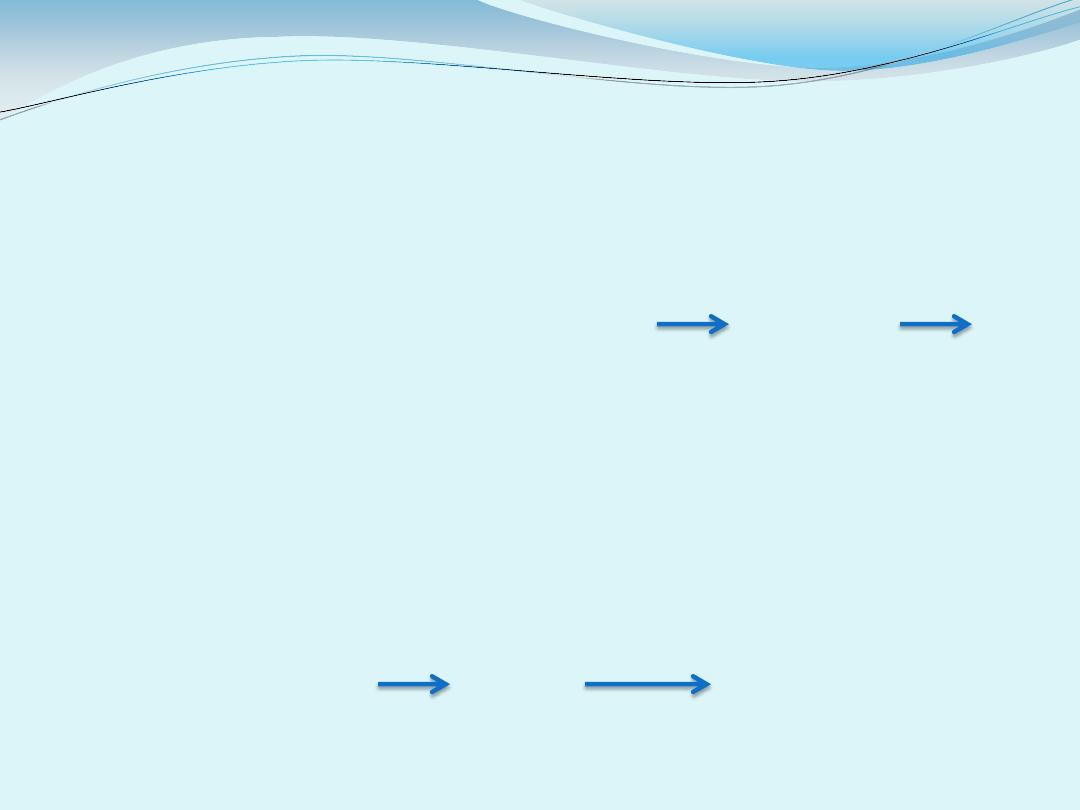
Genus plasmodium requires 2 host to complete their life
cycle
-Vertebrate host
Bird, man
where asexual cycle takes place
(
intermediate
host
)
Asexual =schizogony (Trophozoite → schizont →
merozoite)
-Vector host
Female Anopheline mosquito
where
sexual cycle takes
place (
final or difinitine host
)
Sexual= gametogony microgamete unites macrogamete →
zygote
Sporogony = zygote → oocyst → sporozoites
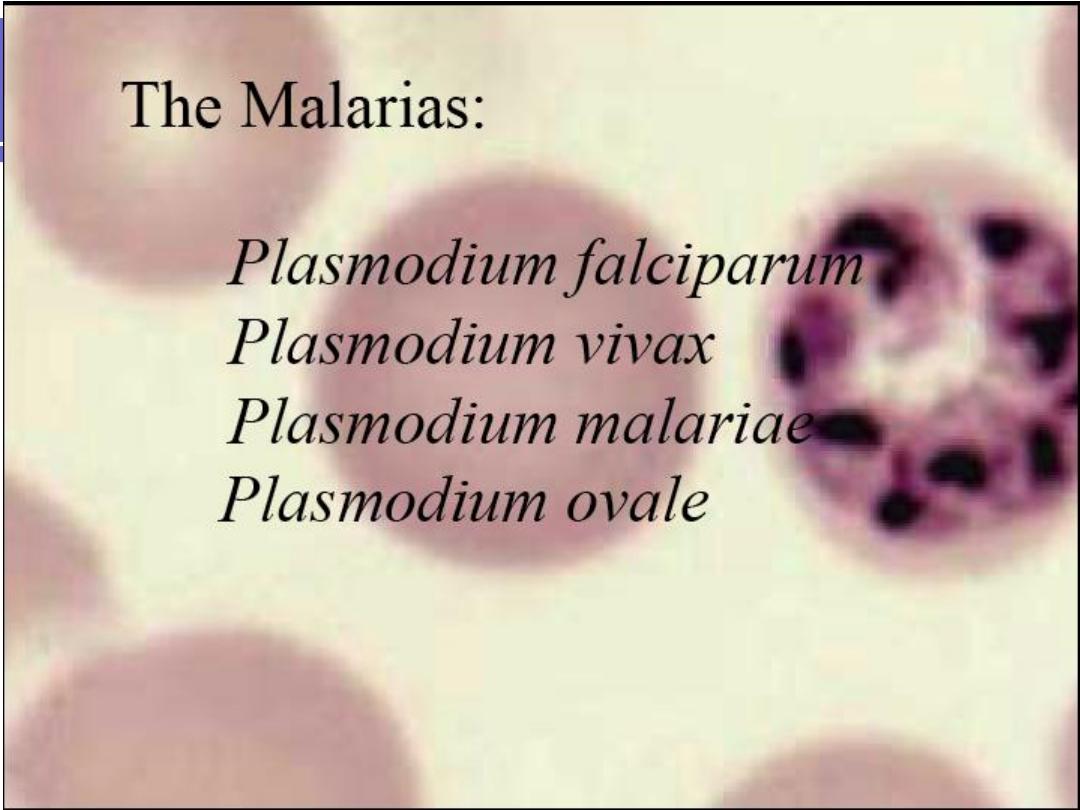
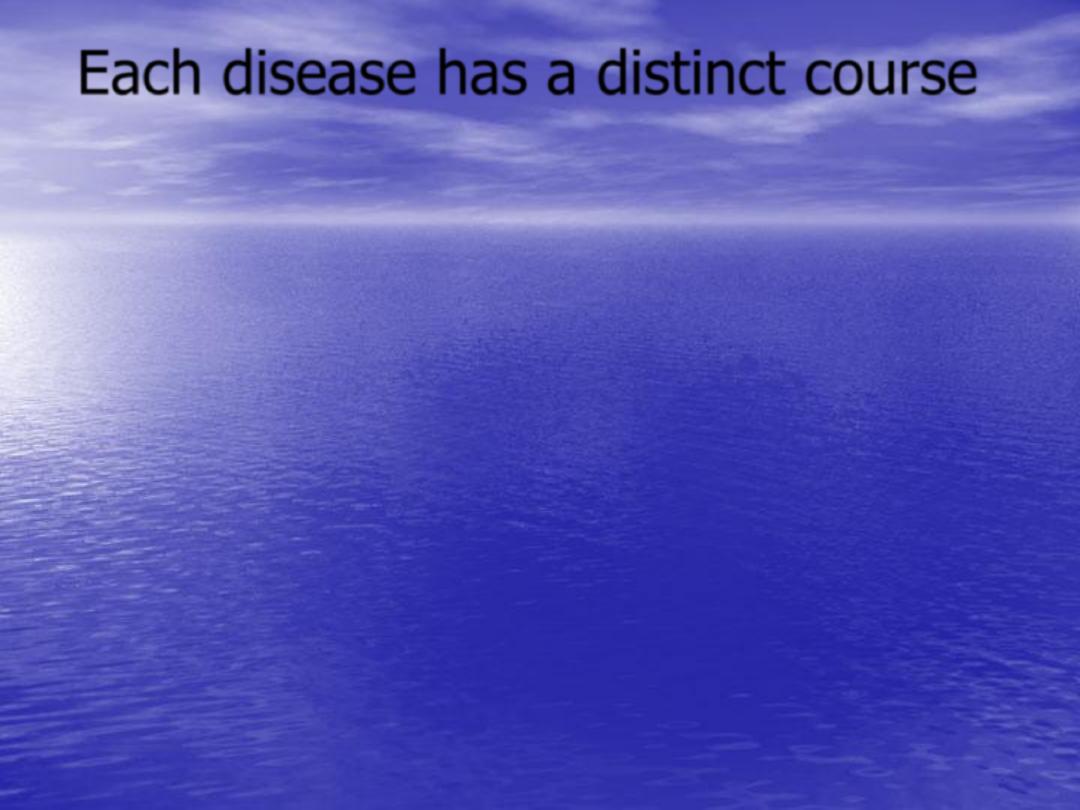
Each disease has a distinct course
“Tertian Malaria”
(P.falciparum, P.ovale and P.vivax)
fever occurs every third day.
“
Quartan Malaria”
(P. malariae)
fever occurs every fourth day.
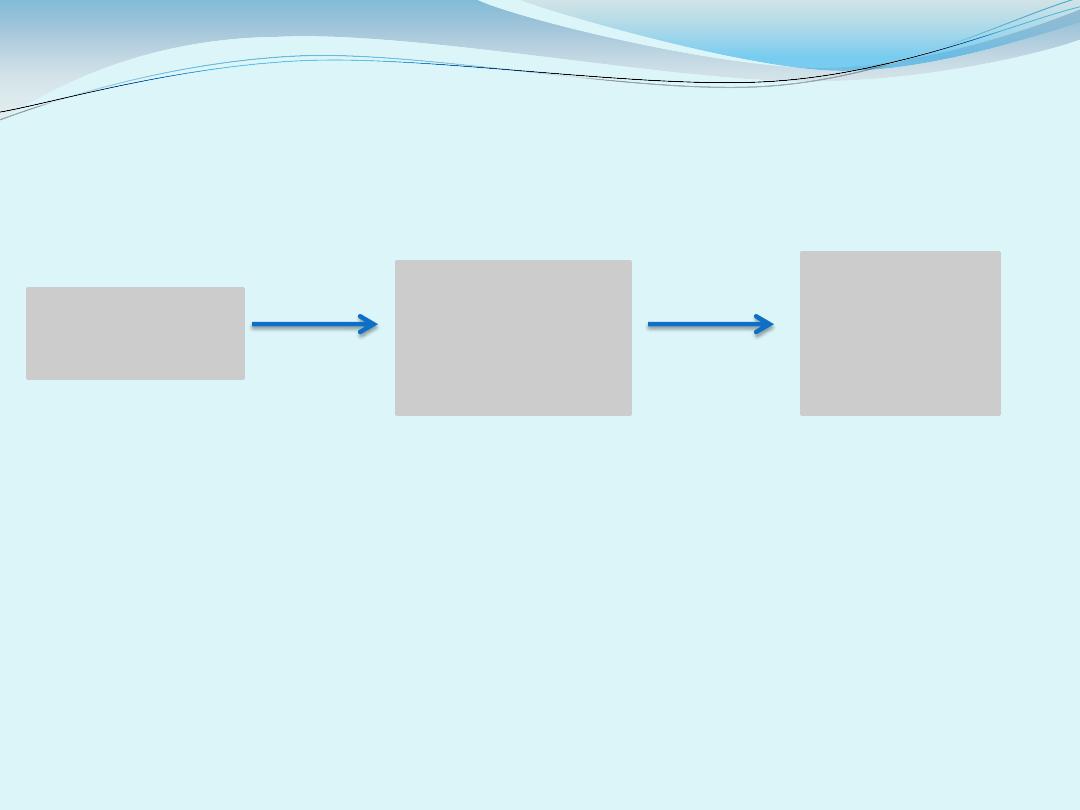
*Malarial parasite in man established their 1
st
foci in non
phagocytic cell of the liver
(hepatocyte
)=pre erythrocytic
cycle before the released into circulating blood to
parasitize RBC where erythrocytic cycle established
Life cycle
Man only
reservoir
infected stage is the sporozoite
Infection
person
Insect female
Anopheline
mosquito
Un
infected
person
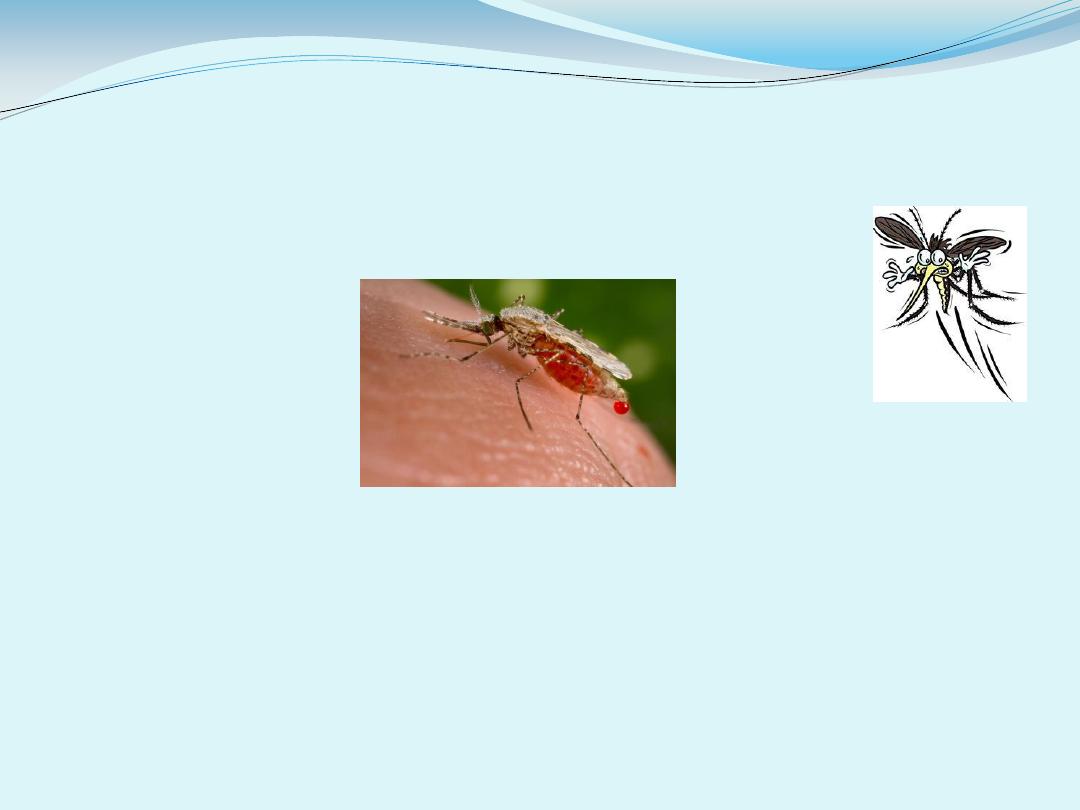
Malaria
Malaria parasites are transmitted from one person to
another by the female anopheline mosquito.
The males do not transmit the disease as they feed only on plant
juices.
There are about 380 species of anopheline mosquito, but only 60
or so are able to transmit the parasite
.
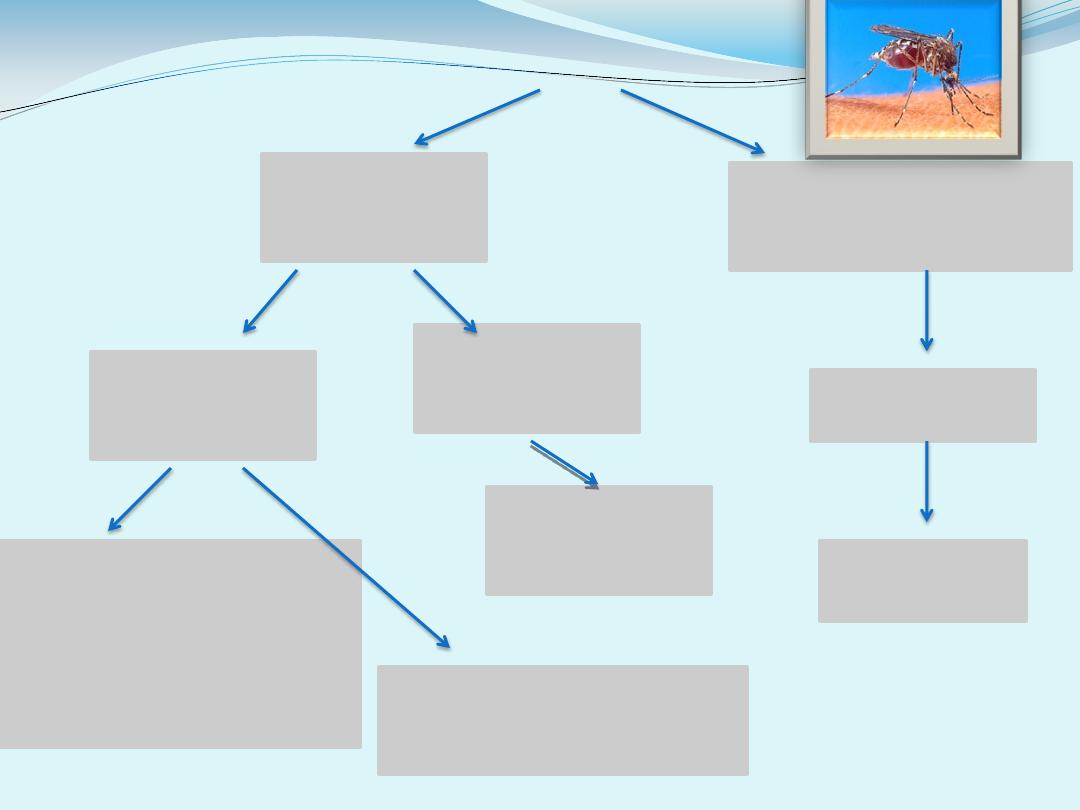
Life cycle
Vertebrate
man
Invertebretes
Female mosquito
Tissue phase
“liver”
Blood
phase
sporogony
gametogony
Erythrocytic
cycle (E.C.)
Secondary E.E.C
Para-erythocytic cycle
Primary
Exo-erythrocytic
cycle
Primary E.E.C.
Pre-erythocytic cycle
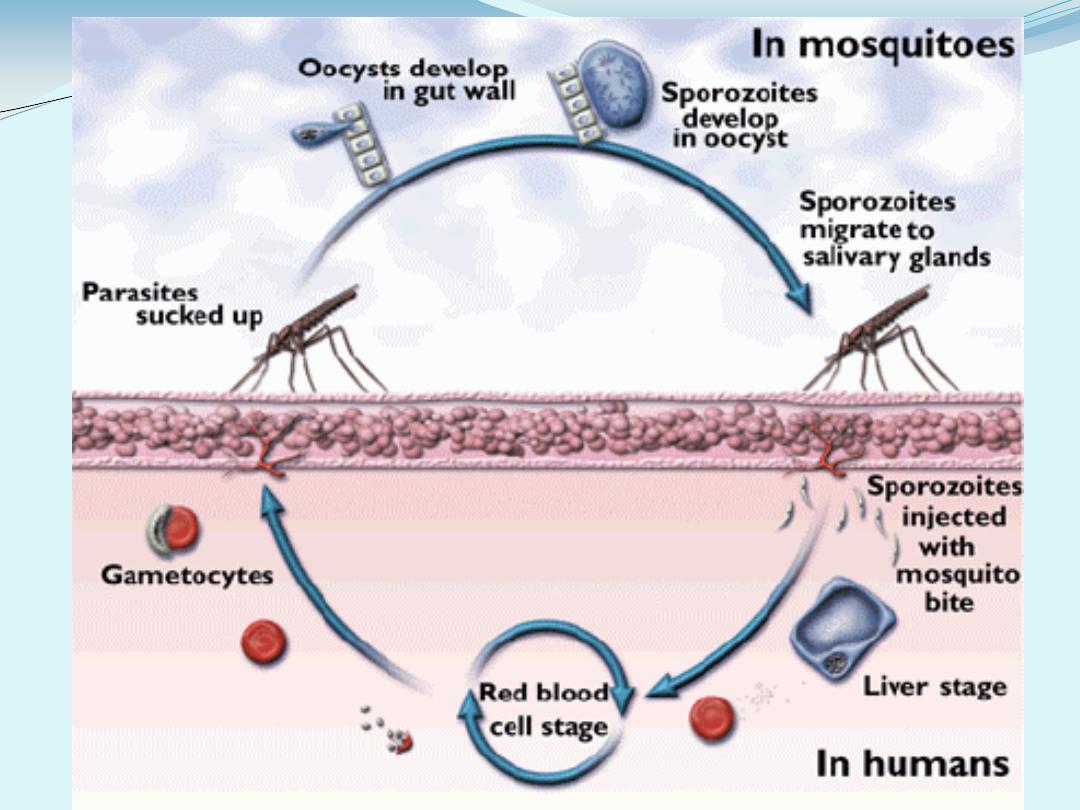

Man becomes infected with malaria when female
anopheline mosquito introduce the infective stage the
sporozoite
with its saliva during sucking of the blood
These sporozoites are tiny elongated spindle shape about 10-
15µ in length with pointed ends
So they enter the man through the skin then they reach the
blood & within less than an hour they enter the
parenchyma cells of the liver
The sporozoite surface is covered by a protein called
circum
sporozoite protein
which is specifically enters the liver
cells not other cells
In the liver the sporozoite starts primary E.E.C.
Primary Exo-erythrocytic (schizogony)
pre-Erythrocytic schizogony
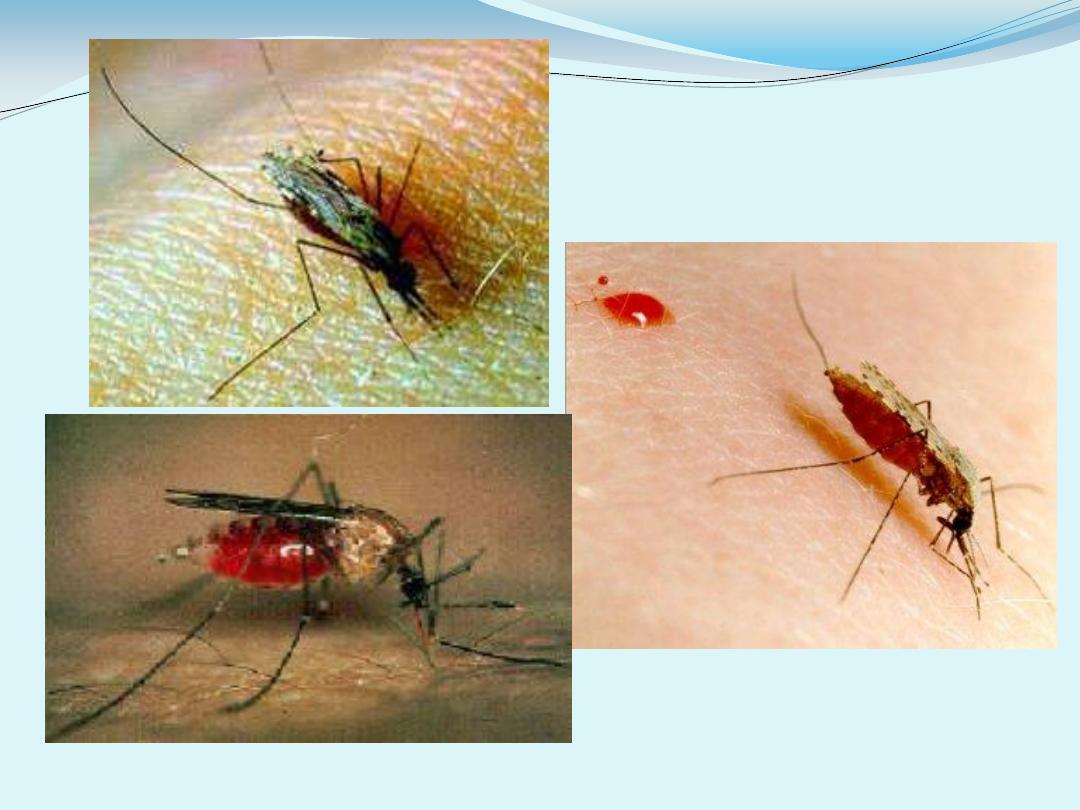
Fig 92 : Anopheles Female (Mosquito)
The vector of malaria
109
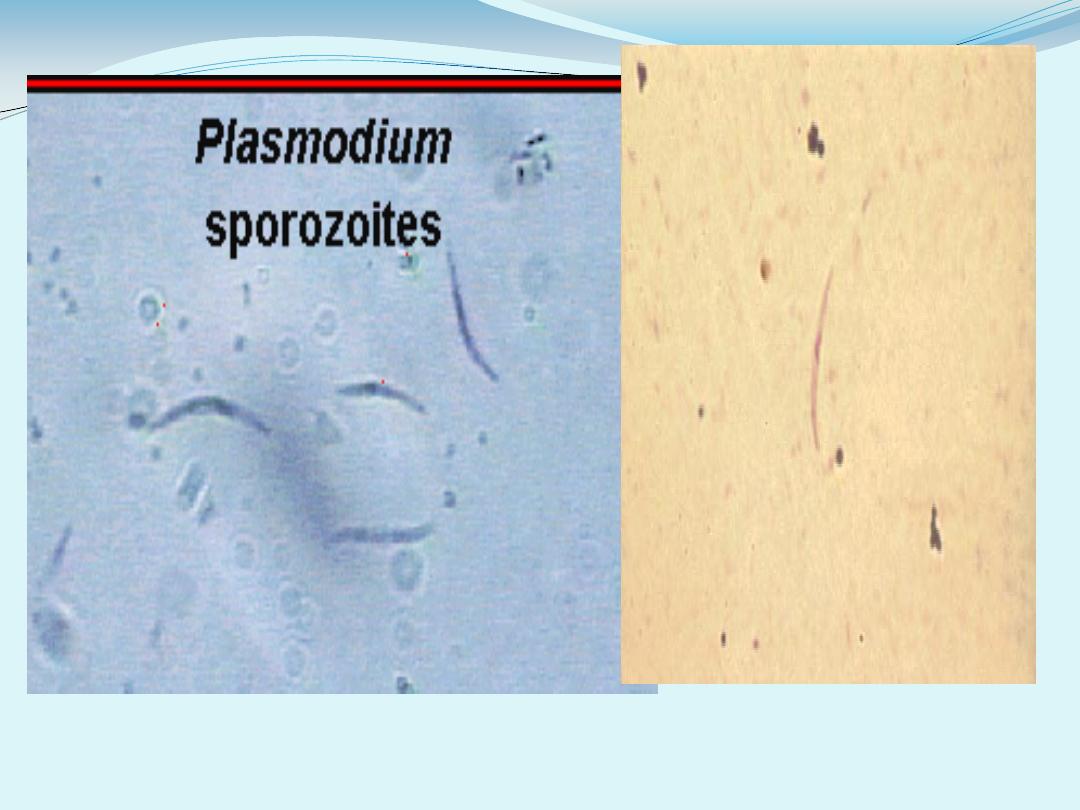
110
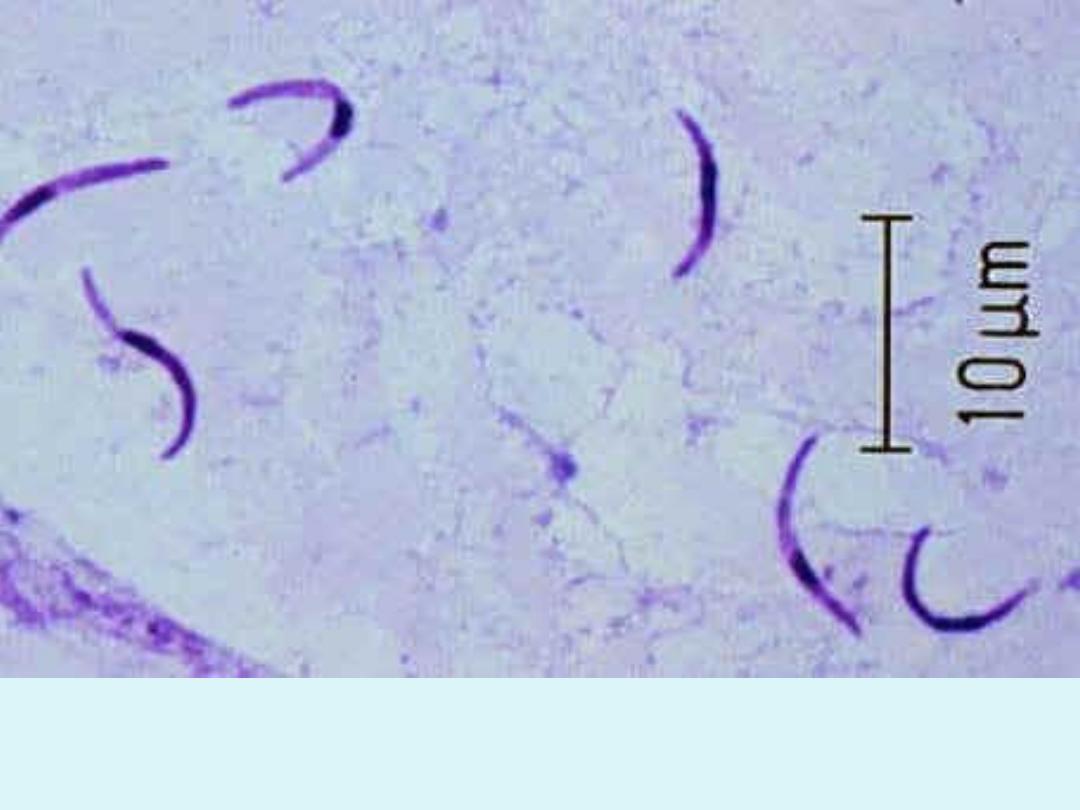
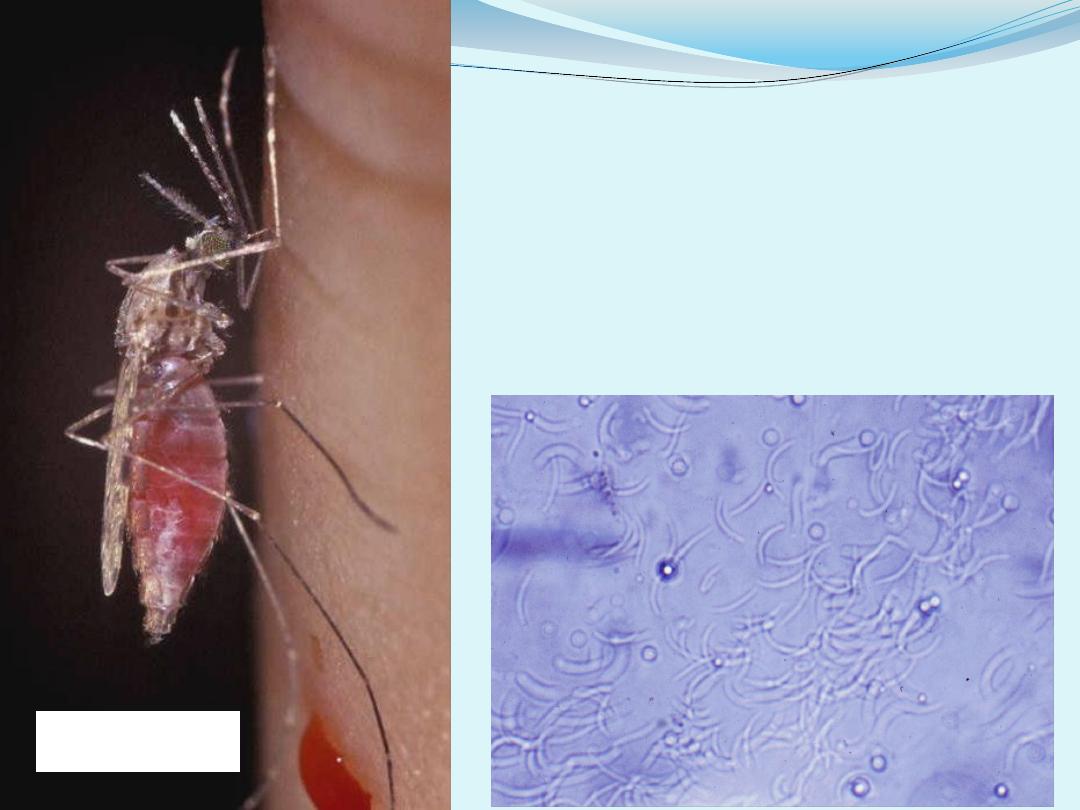
Anopheles
Transmission
• sporozoites injected
with saliva
• enter circulation
• trapped by liver
(receptor-ligand)
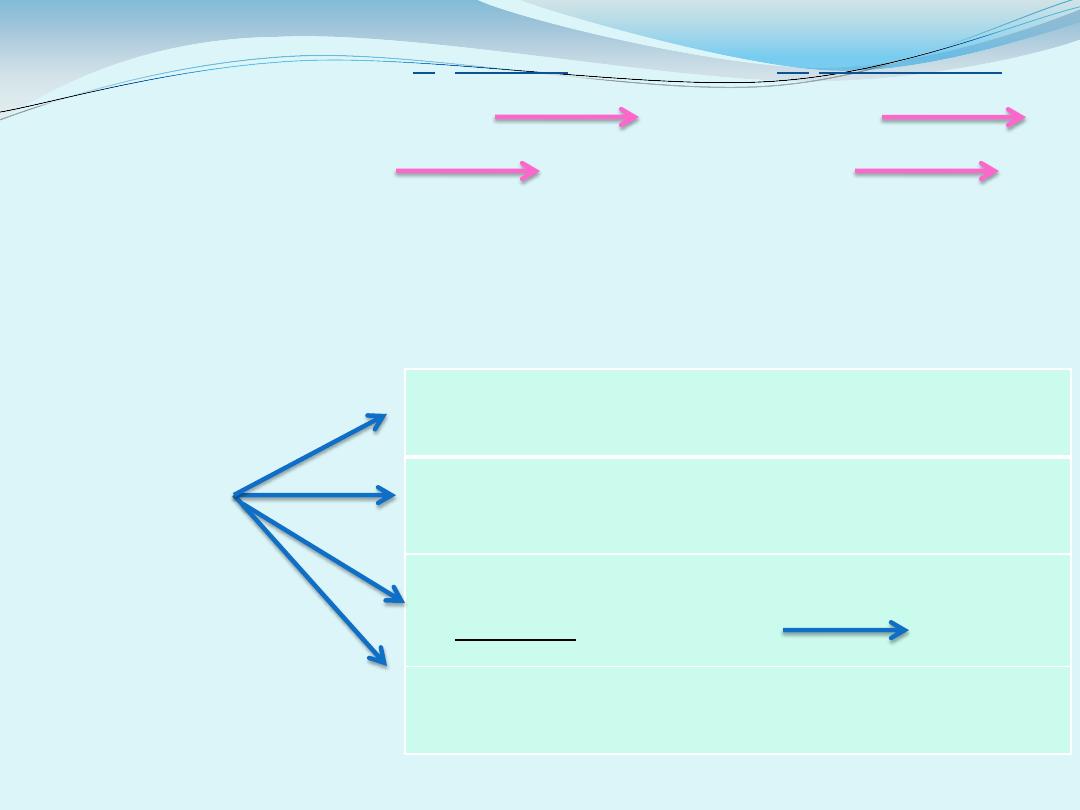
Pre.E.E.C. 8 days in P. Vivax ,6 days in P. falciparum
Sporozoite inside liver cell trophozoites
immature schizont mathure schizont
contain 1000 s of merozoites (cryptozoites)
In the liver no clinical manifestation produced by the
parasite
Merozoites
Phagocytized by kupffer cell
Secondary exo-erythro. cycle
“para-erythro. cycle
Dormant for indifinite time “hypnozoite”
in P. vivax & ovale only
relapse
Blood erythocytic cycle
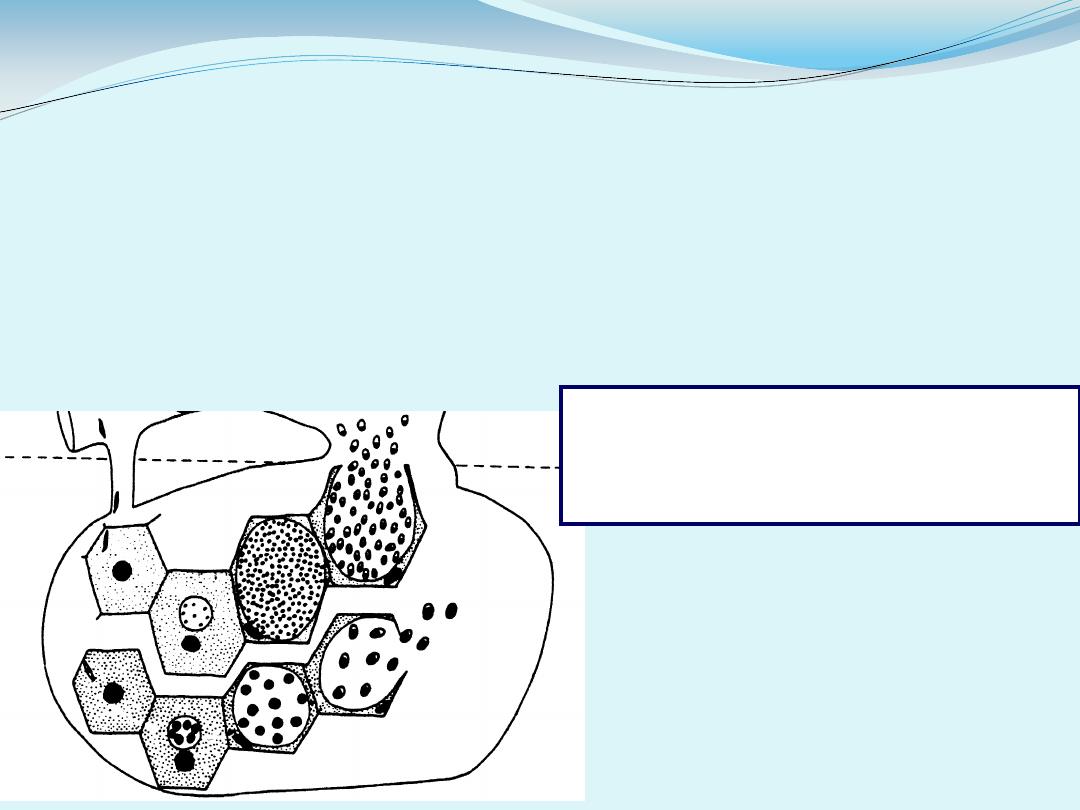
Hyponozoite Forms
• some Merozoites exhibit delayed
replication (ie, dormant)
• merozoites produced months after
initial infection
• only P. vivax and P. ovale
relapse = hypnozoite
recrudescence = P.malariae
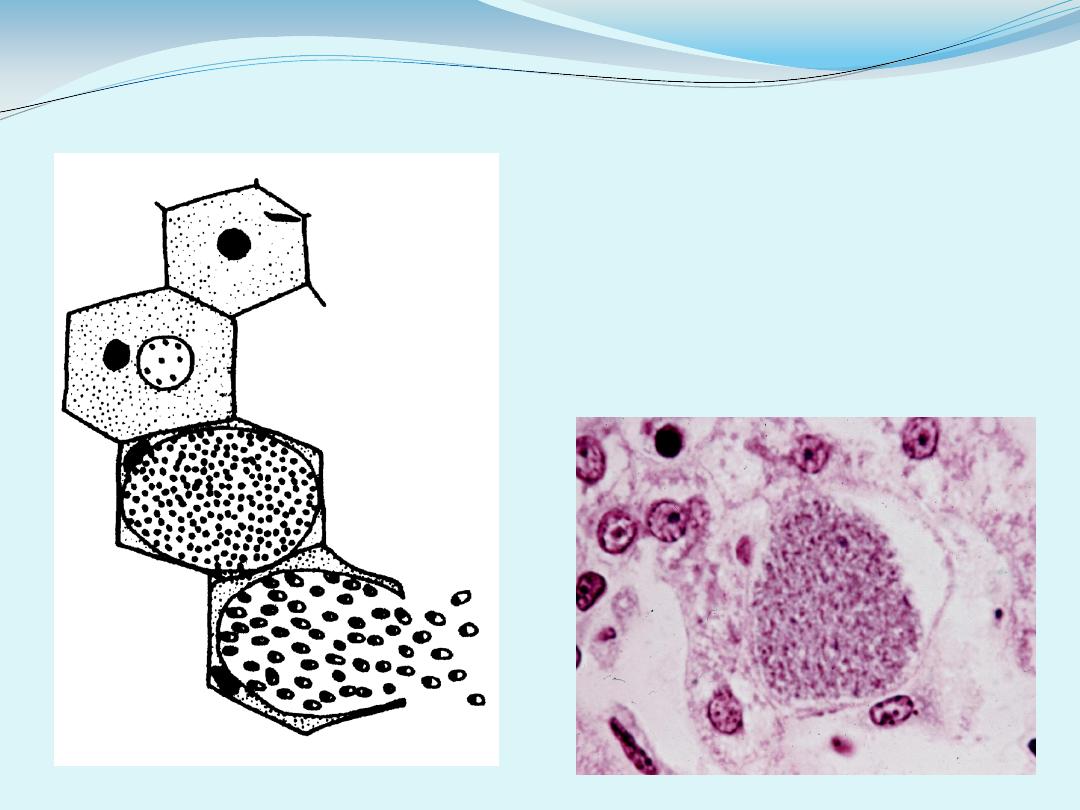
Exoerythrocytic Schizogony
• hepatocyte invasion
• asexual replication
• 6-15 days
• 1000-10,000 merozoites
• no overt pathology
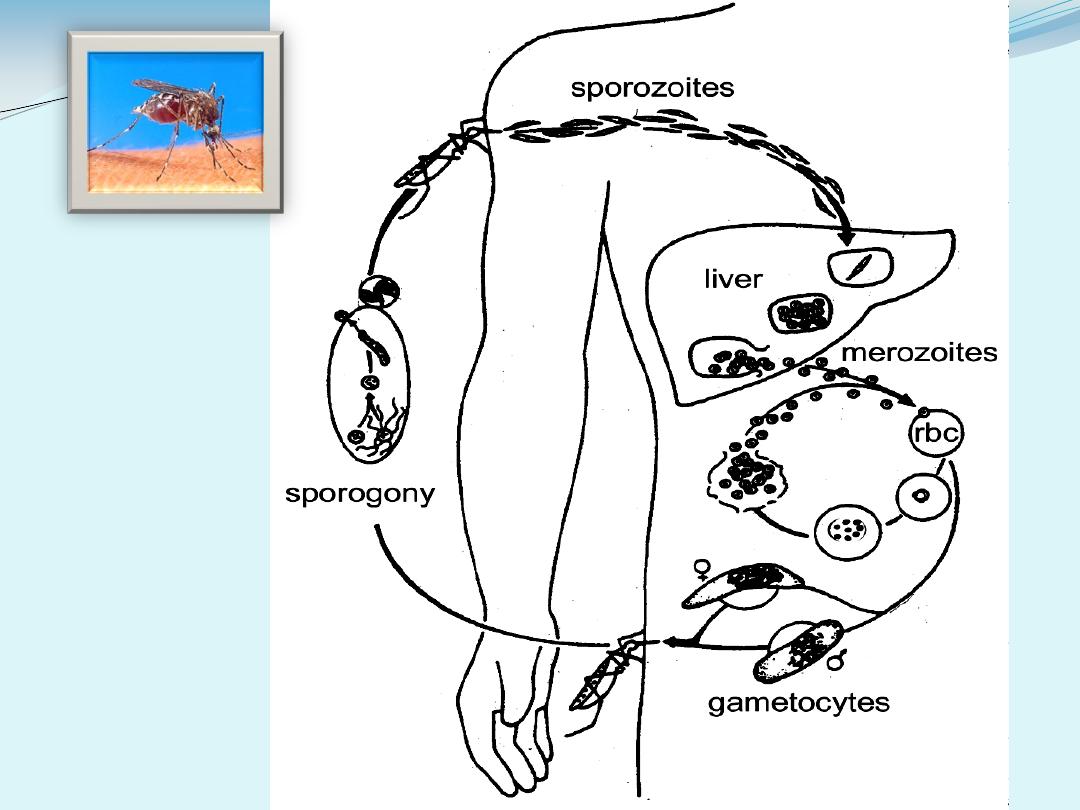

Erythrocytic Cycle (vivax 48 hour)
Inside RBC
Merozoite enter RBC ,cytoplasm of RBC ingested by the parasite
large food vacuole giving the appearance of a ring
(nucleus at one end)
Ring stage
,As the trophozoite grows
,vacuole becomes less ,but pigmented granules of hemozoin in
the vacuole become apparent
Hemozoin
It is the end product of parasite´s digestion of the host’s Hb ,the
trophozoite incompletely utilize Hb leaving residues of globin &
an iron.
Prophyrin-hematin
which is an insoluble polymer also
called malaria pigment (compound of protein +hematin), it has a
toxic effect on the body & macrophage ,depressing their
phagocytes activity
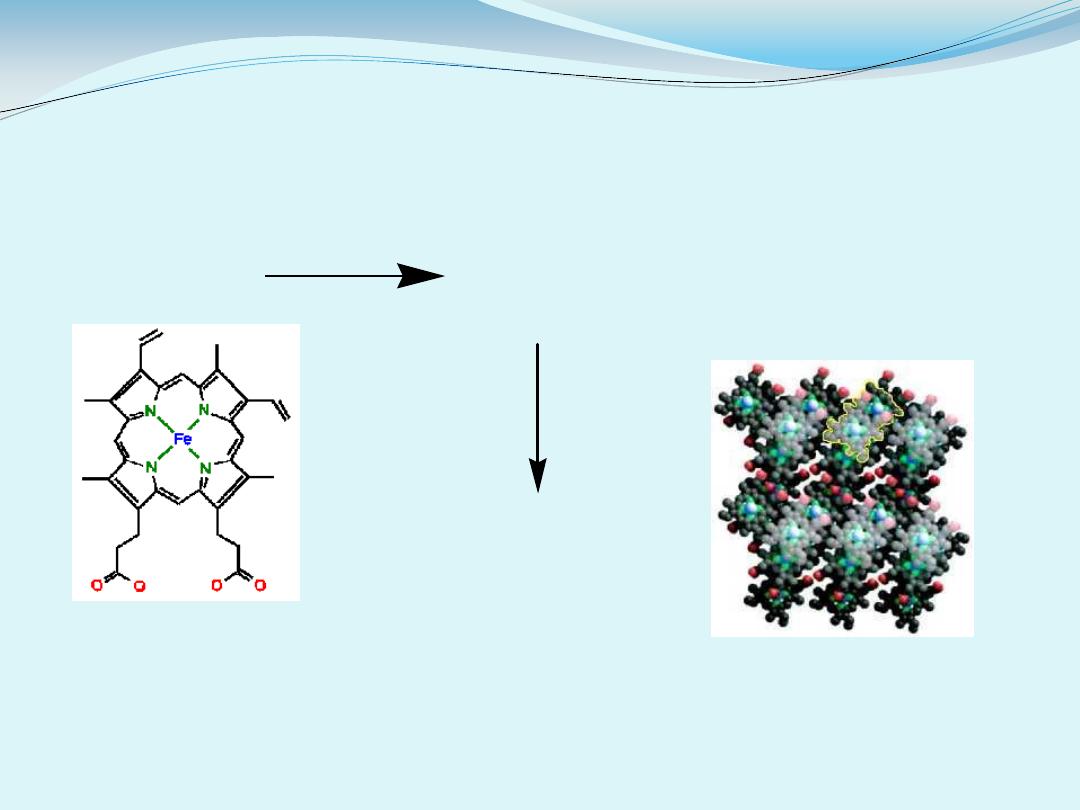
HEMOGLOBIN HEME +GLOBIN(PROTEIN PART)
HEMOZOIN
HEME
HEMOZOIN
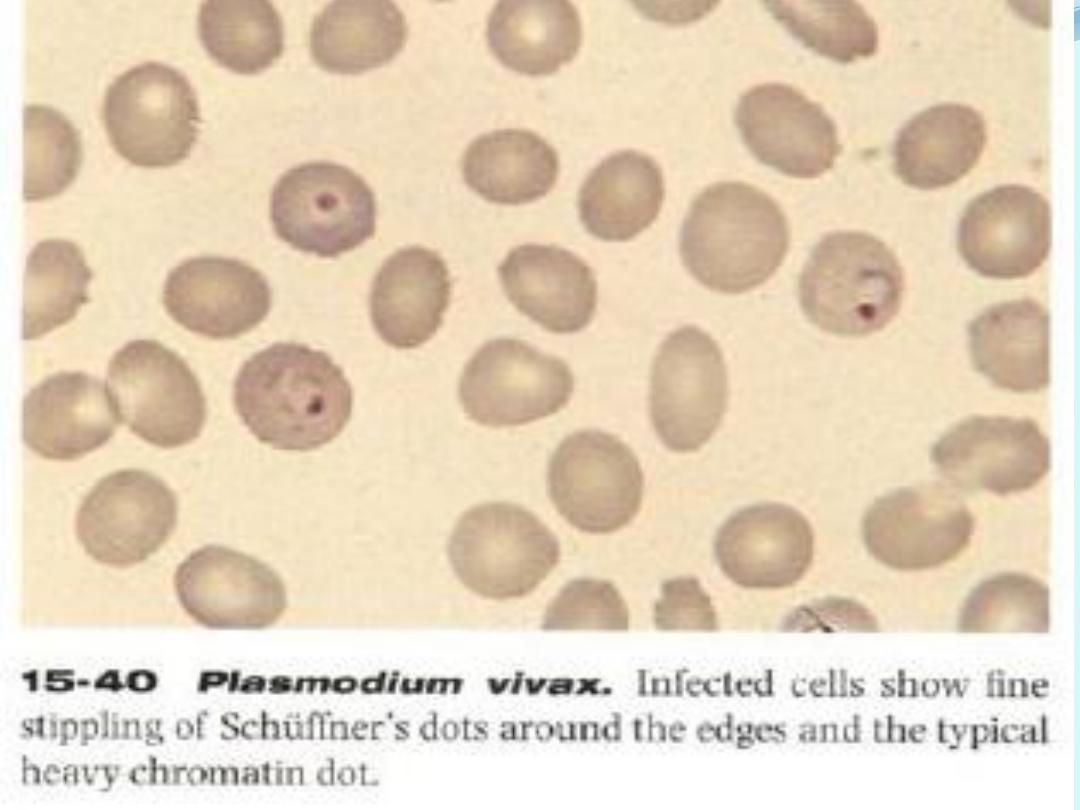
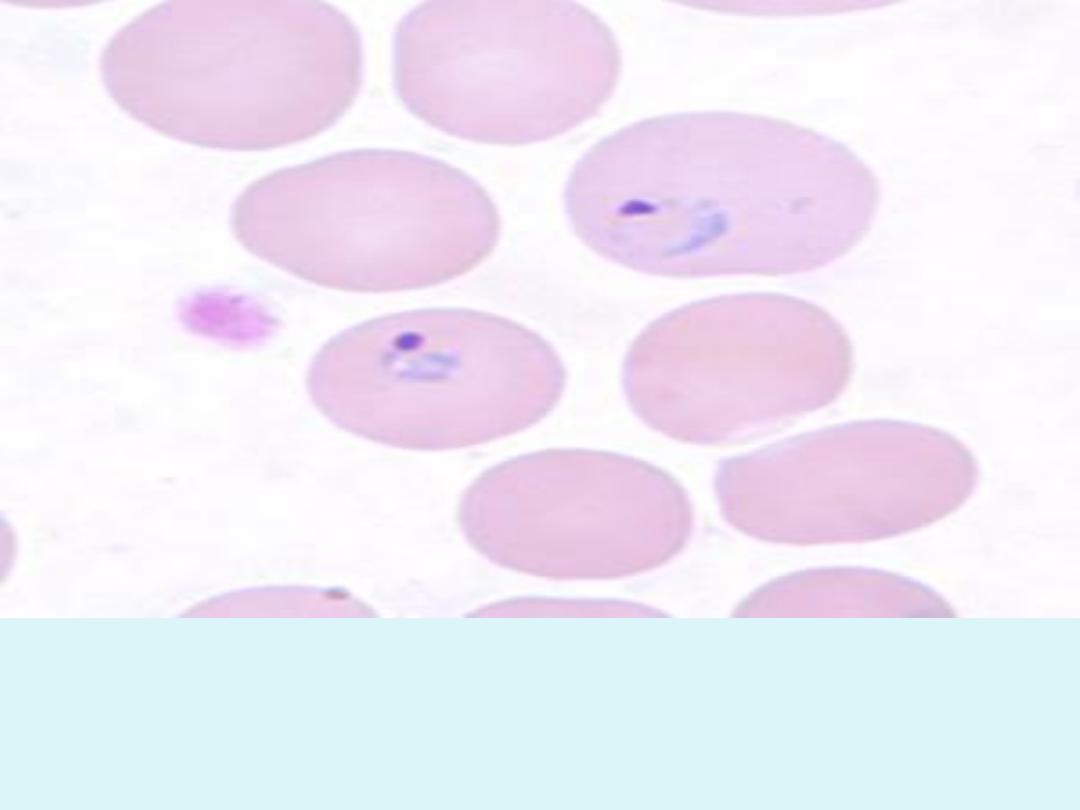

As the trophozoite grows the ring enlarges with pseudopodia in
all direction this stage called
Amoeboid stage
Here in vivax the infected RBC enlarged ,lose it’s pink color
(pale) & develops a peculiar
stippling “invaginations in the
surface of the infected RBC “ called
Schuffner's dots
After 24 hour vacuole disappears & nuclear division started (12-
24nuclei) this is called
Immature schizont
Then cytoplasmic division
mature schizont
with specific
number of merozoint in each type “12-24” usually 16
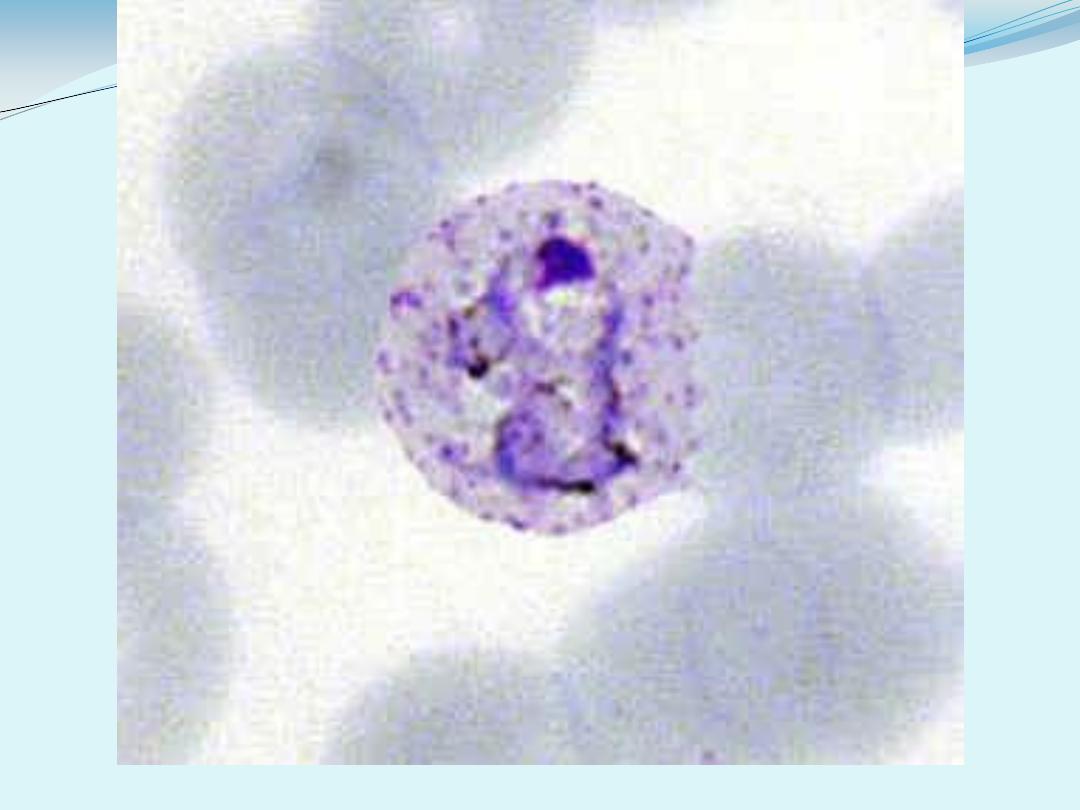
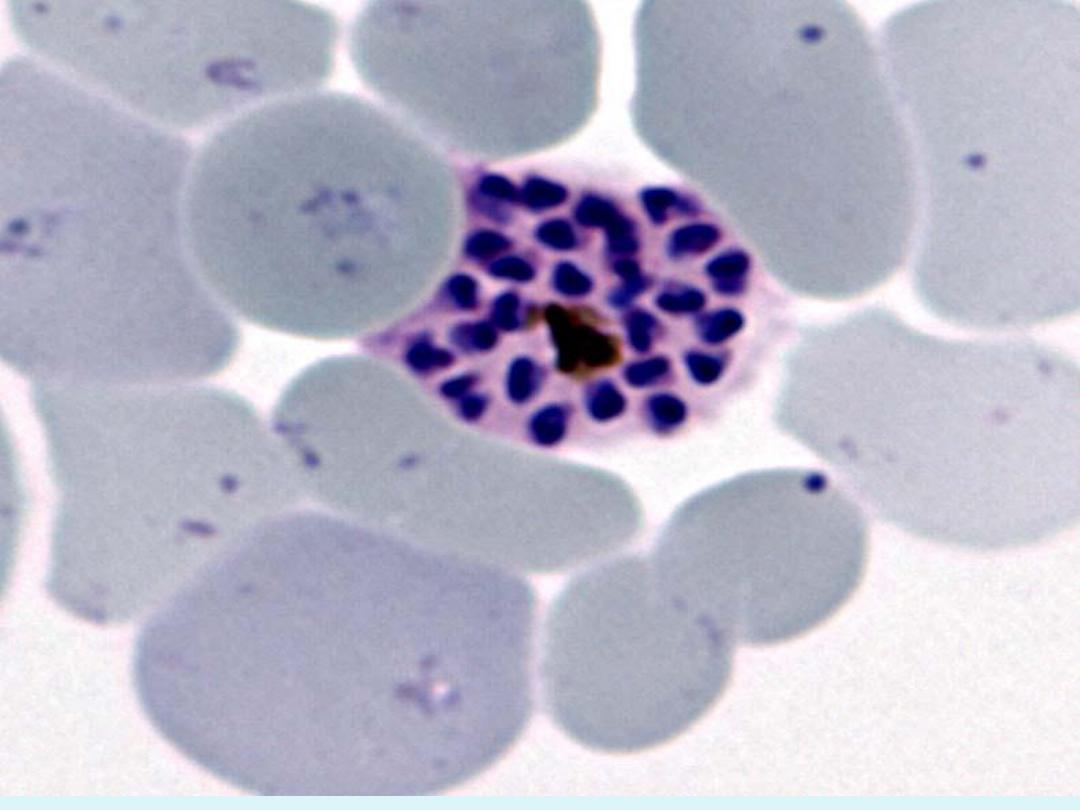

Then RBC rupture & releazing
merozoites(parasites)+metabolic wastes
inclucing hemozoin which responsible for
symptoms of malaria
Merozoites enter new RBC & repeat eryth.
cycle (every 48hr)
After an indeterminate number of asexual cycle
(eryth. cycle ) some merozoites when enter
RBC become m
i
crogametocyte( male) or
m
a
crogametocyte (female)

These gametocytes develope in RBC in the
capillary of internal organ (spleen + Bone
Marrow) & go to peripheral blood only when
become mature (96hr) twice the time of E.
schizogony
The mature gametocyte unless ingested by
female anopheline mosq. It will be die &
phagocytized
Individual who harbor
gametocytes in his peripheral
blood is called carrier
When female anopheline mosq. takes
erythrocytes containing gametocytes the sexual
cycle begin :
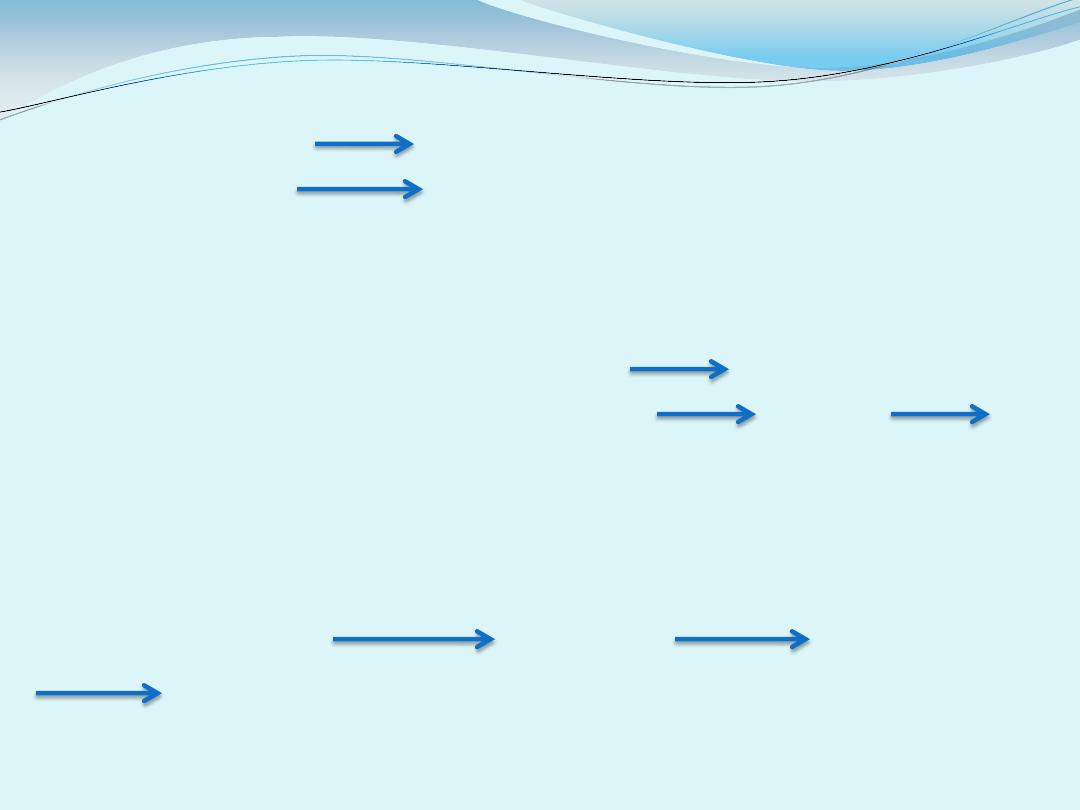
Sexual cycle : (gametogony ) + sporogony
In the female anoph. mosq. gametocytes develops in to gametes
Macro gametocyte one macrogamete
Microgametocyte 6-8 microgamete ,by process called
exflagellation
Exflagellation
:the nucleus of microgamete is divided into 6-8
daughter nuclei then axoneme is developed ,then the flagella buds
with their associated nuclei to outwards 6-8 microgametes
One micro gametes fertilize macrogamete zygote
mobile ookinete
(in the gut of mosq.)
Ookinete penetrates the gut mucosa of female anoph. mosq. To the
hemocoel side (outer side ) of the gut
→
oocyte which contains
the sporoblast that divided rapidly to form thousands of
sporozoites
break out of oocyte hemocoel salivary gland
next patient
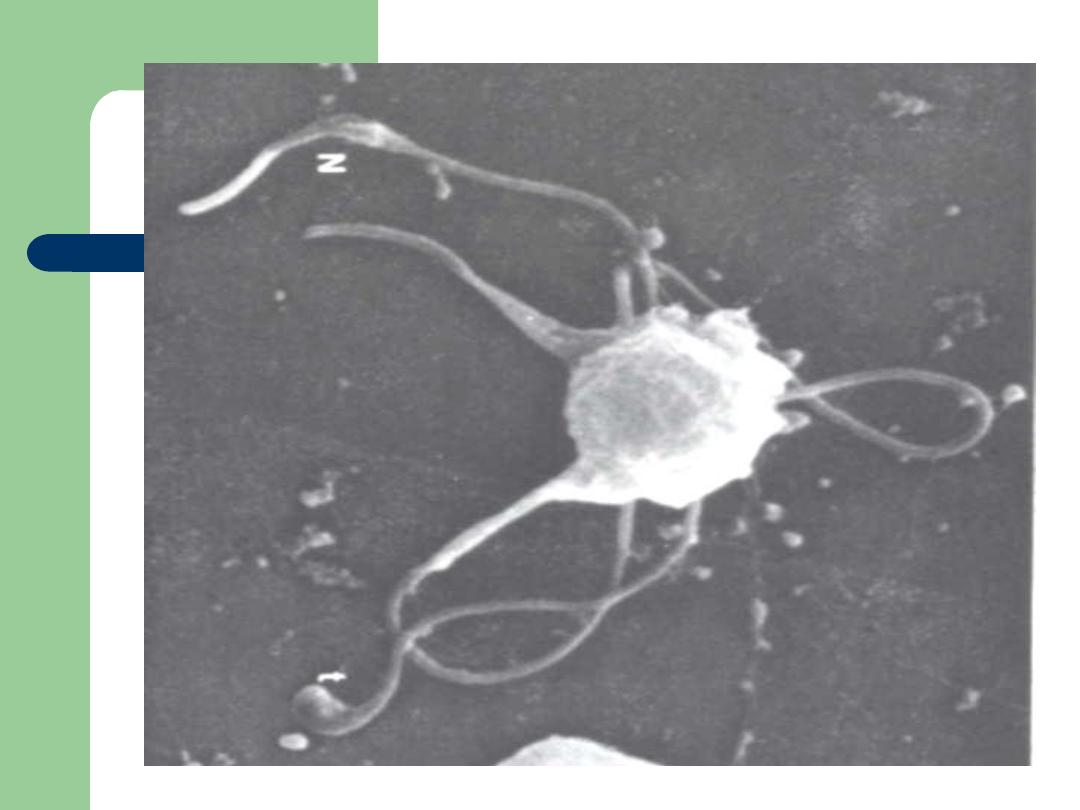

Sporogony
• occurs in mosquito (9-21 d)
• fusion of micro- and
macrogametes
• zygote
ookinete (~24 hr)
• ookinete transverses gut
epithelium ('trans-invasion')
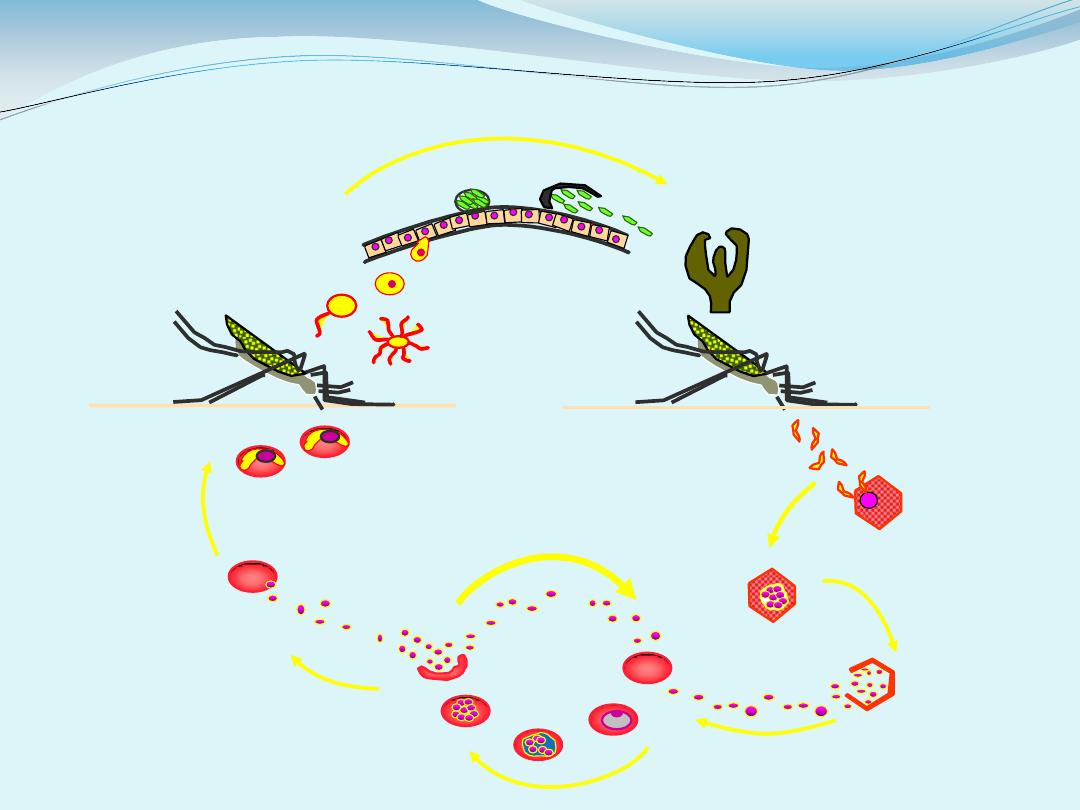
Liver stage
Sporozoites
Mosquito Salivary
Gland
Malaria Life
Cycle
Gametocyte
s
Oocyst
Red Blood Cell
Cycle
Zygote
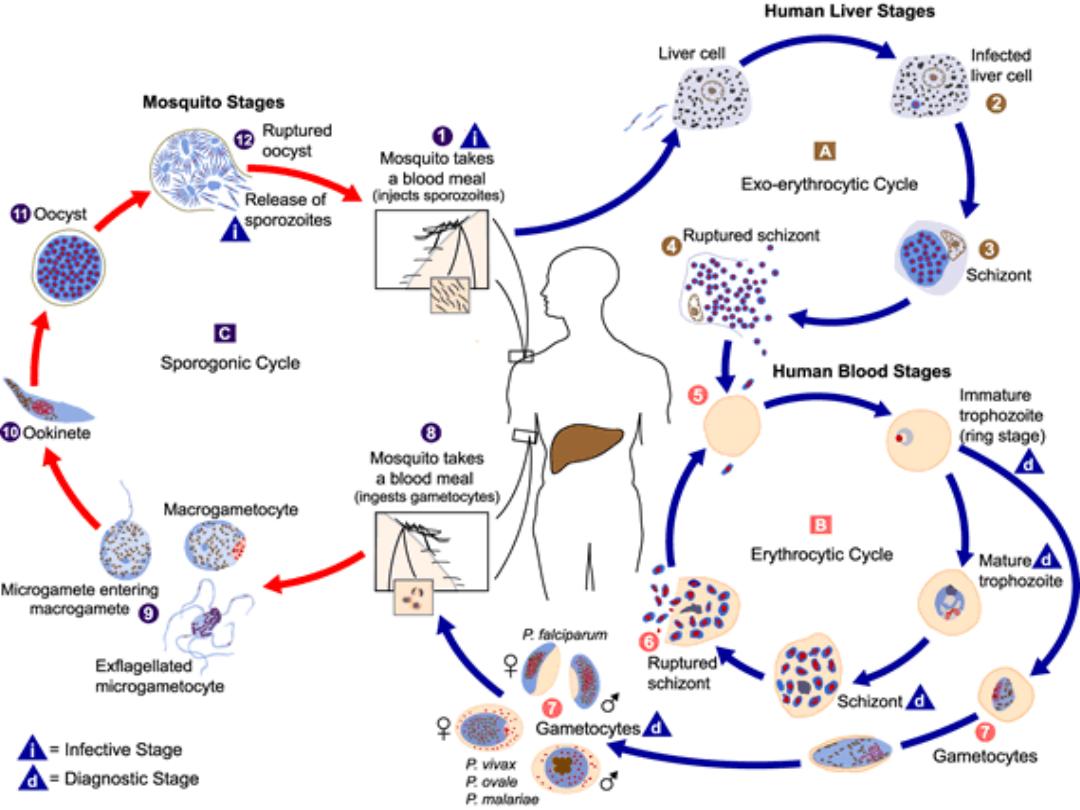

Method of transmission
*sporozoite induced
The infective stage is sporozoite by biting of female
anoph. mosq. porter of entry =skin
*trophozoite induced
Blood transfusion especially
P. malaria
syringe ,lab.
accident & rarely congenital infection

P. Vivax :
43% of malaria in the world some merozoites remain in the
liver hypenozoite so relapse
Merozoite invades
only young RBC (reticulocyte)
unable to
invade fully mature RBC ,black people have got natural
resistance to p. vivax infection ,because merozoite enter RBC
through receptor which is the duffy blood group protein
Ag fy a ,fy b
Black people usually with no such Ag fy0
infected RBC in P. vivax enlarge ,pale ,with
schuffner’s dots ,(fine dots)
Schizont in E. cycle with 12-24 hr usually 16 merozoits
E. cycle with 48 hr periodicity = tertian malaria
a
a

P. Falciparum = malignant ter. m.
50% of human malaria most virulent ,90% of mortality of
malaria greater killer of humanity in tropical zone
No relapse (no hypnozoites)
Invade RBC at any age even reticulocyte so much higher
parasitemia than other types (25% of RBC infected )
Soon after invasion of RBC the trophozoite produce protein
that are deposite in the eryth. surface membrane in the
deformation called
knobs,
these protein bind to certain
glyco-protein on the post capillary venular endothelium this
binding cause sequestration of the infected RBCs so stick to
venular endothelium , also those RBCs stick to normal
RBC thrombosis
Gametocyte don’t produce these knobs so gametocyte infected
RBCs don’t stick
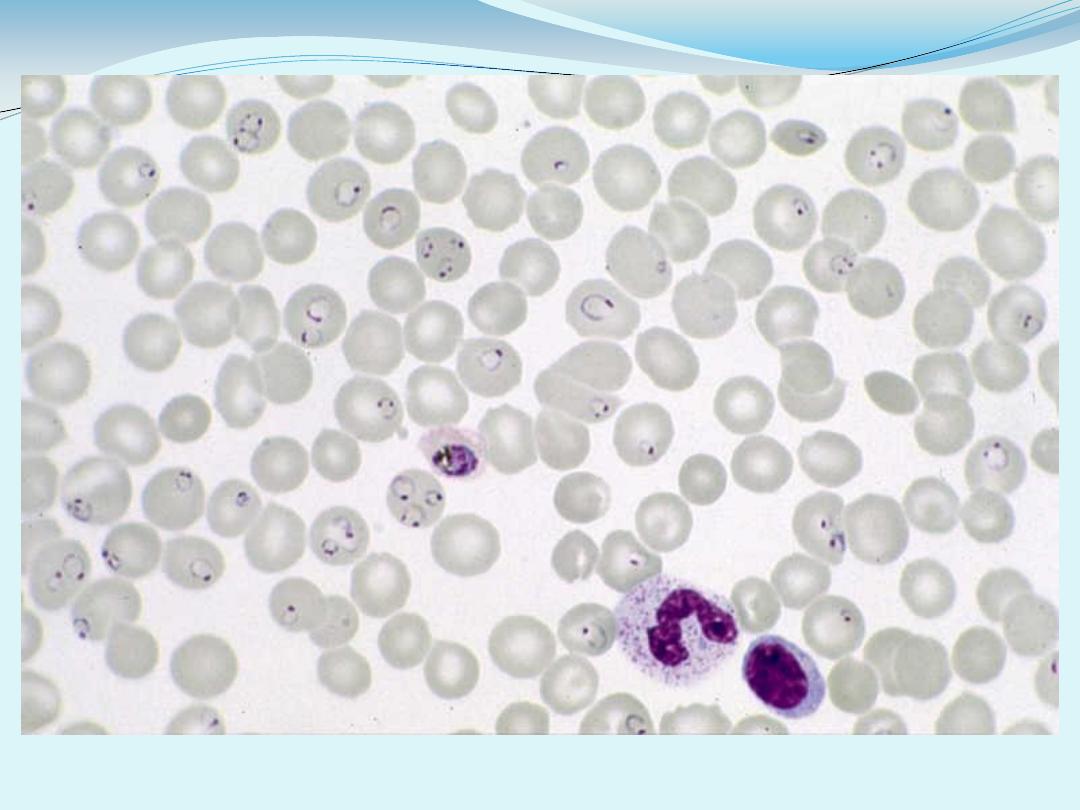
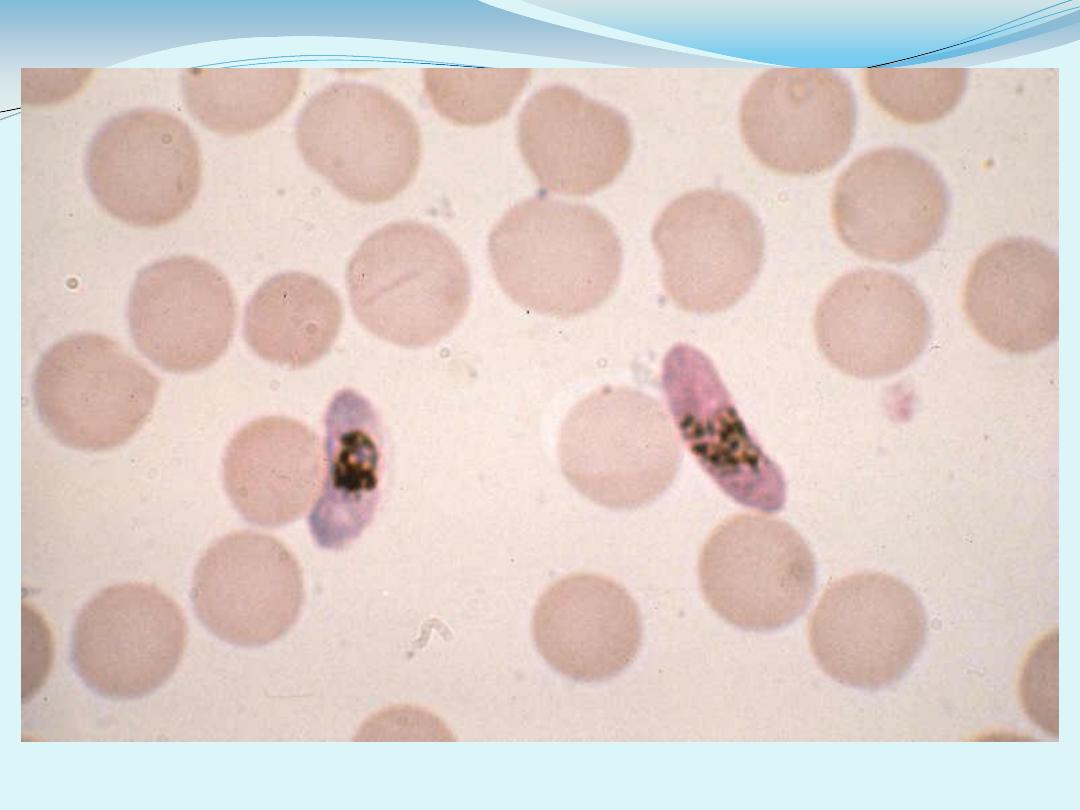

So in the peripheral blood only the early ring stages &
gametocyte are seen in P. falciparum
Ring stage in P. falciparum are smallest than other species
,multiple infection of the same RBC is common ,rings with bi
nucleated (2 chromatin dots) also present
may be division of the ring
RBC with Maurer's dots larger than the fine schiiffner’s dots of
P. vivax
These dots for transport of nutrient
Amoeboid & schizont (8-32merozoites) ,not seen in the
peripheral blood but in the capillaries of the internal organ
(spleen , B.M.)
Gametocytes are crescent in shape
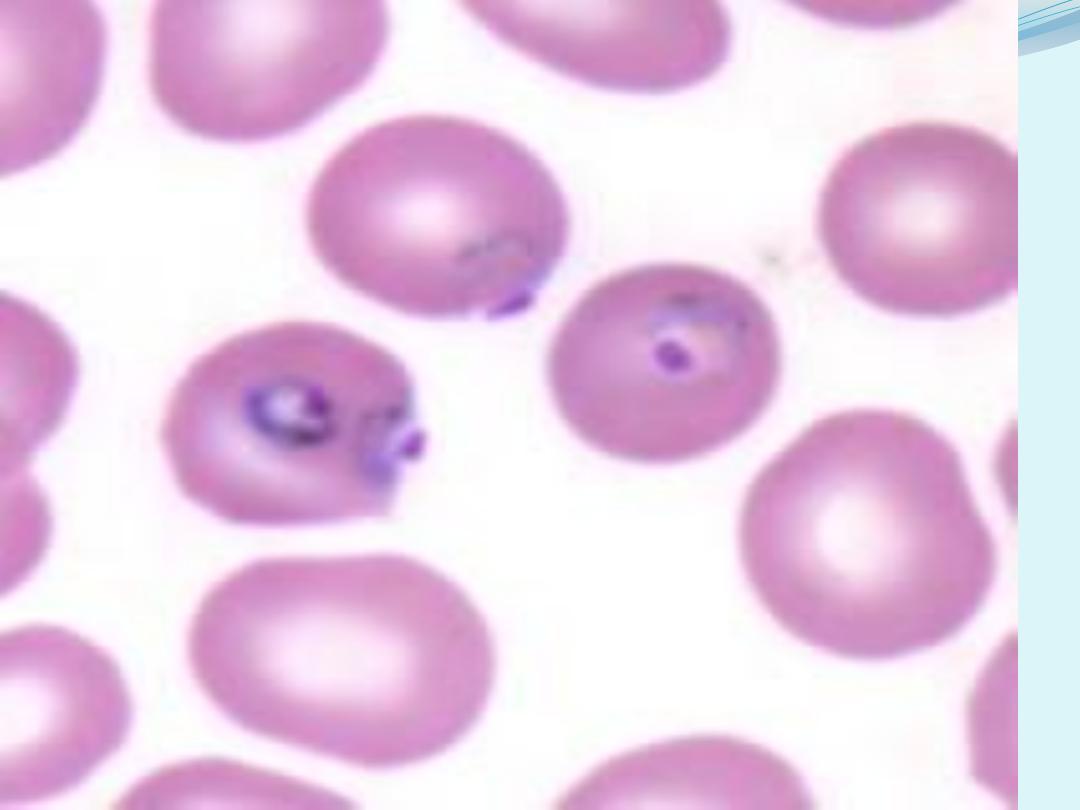
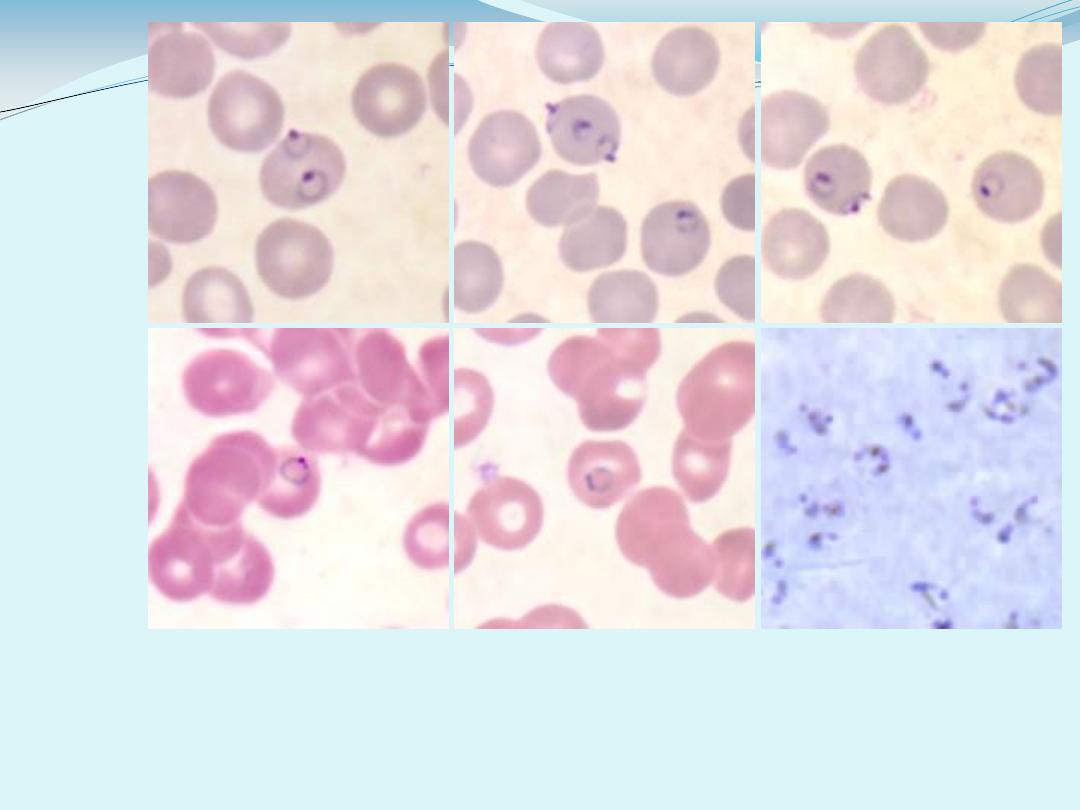
A, B, C: Multiply infected red blood cells with appliqué forms in thin blood
smears
D: Signet ring form.
E: Double chromatin dot
F: A thick blood smear showing many ring forms of P. falciparum (X 1000)
A
B
C
D
E
F
138
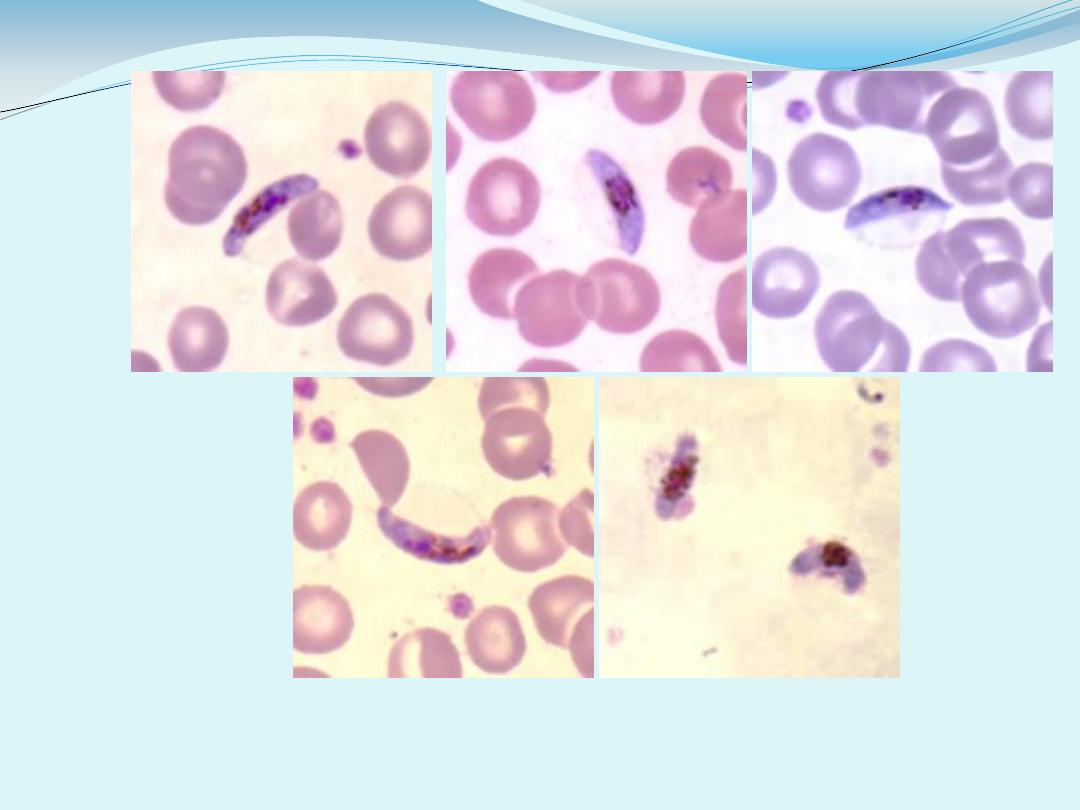
A, B, C, D: Gametocytes of P. falciparum in thin blood smears.
A
B
C
D
E
( X 1000 )
141

P.
Malariae 7%
Quatrain malaria (paroxysm every 72hr), amoeboid band form
schizont 6-12 (9) merozoites in a rosette shape ,infect only old
(aging) RBC so low parasitemia
Can live in blood up to 50 years so important in blood
transfusion ,transmission & cause recrudescence but no relapse
P.
Ovale
Mild tertian malaria ,oval malaria
Rarest type ,RBC oval in shape schuffner’s dots appear
earlyer ,larger more numerous than vivax , schizont
6-12 (9)
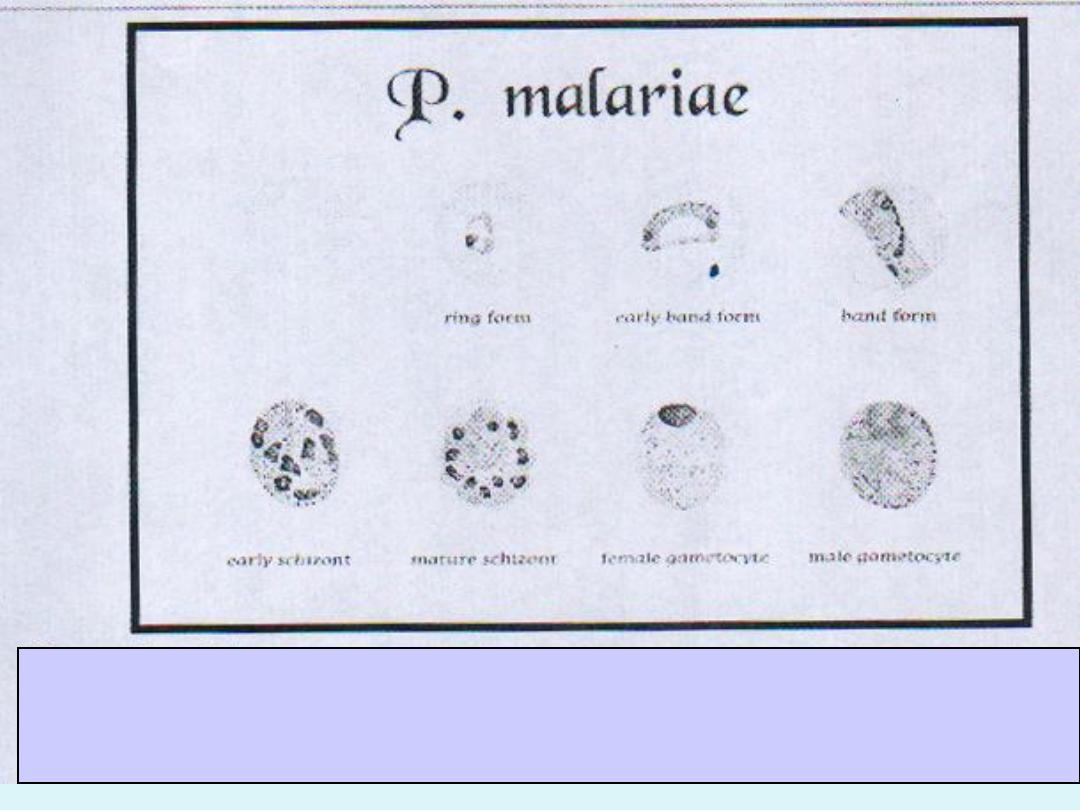
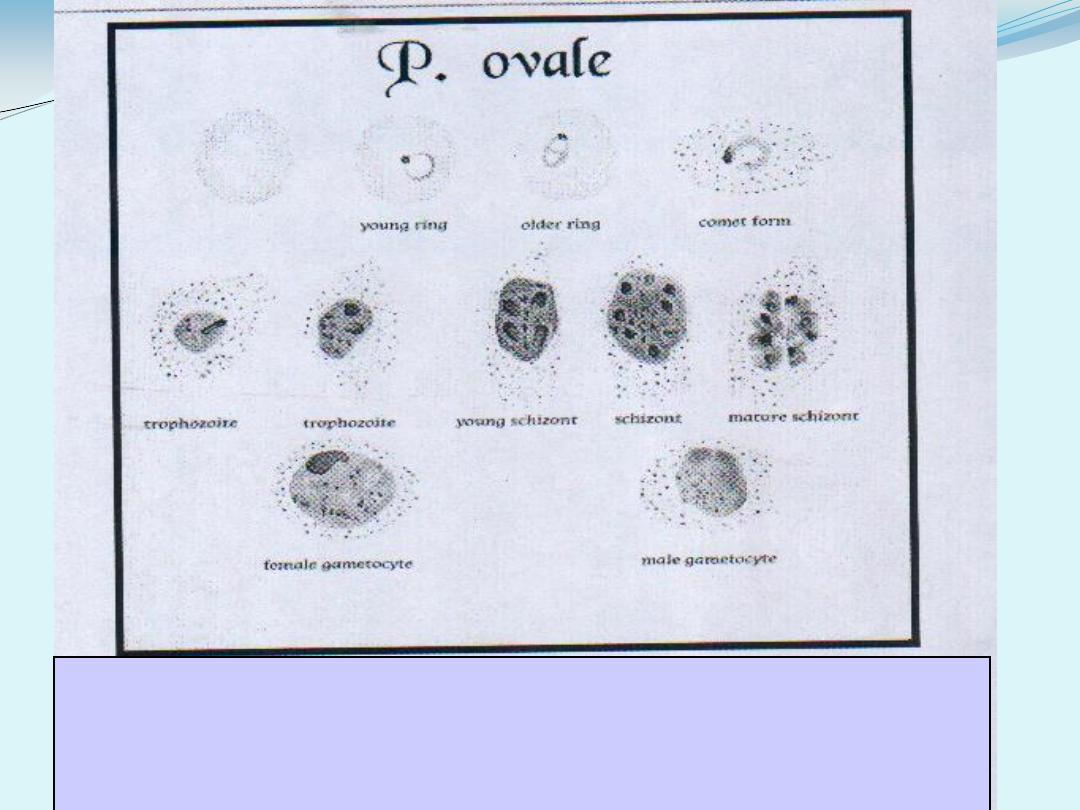
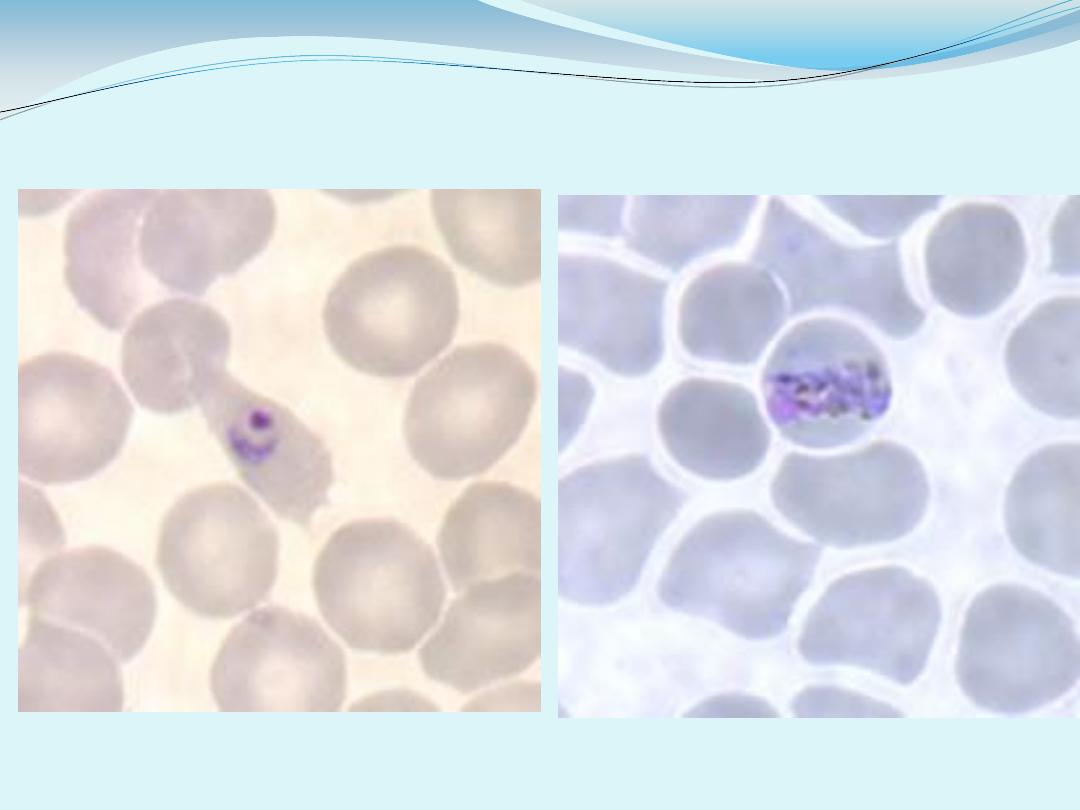
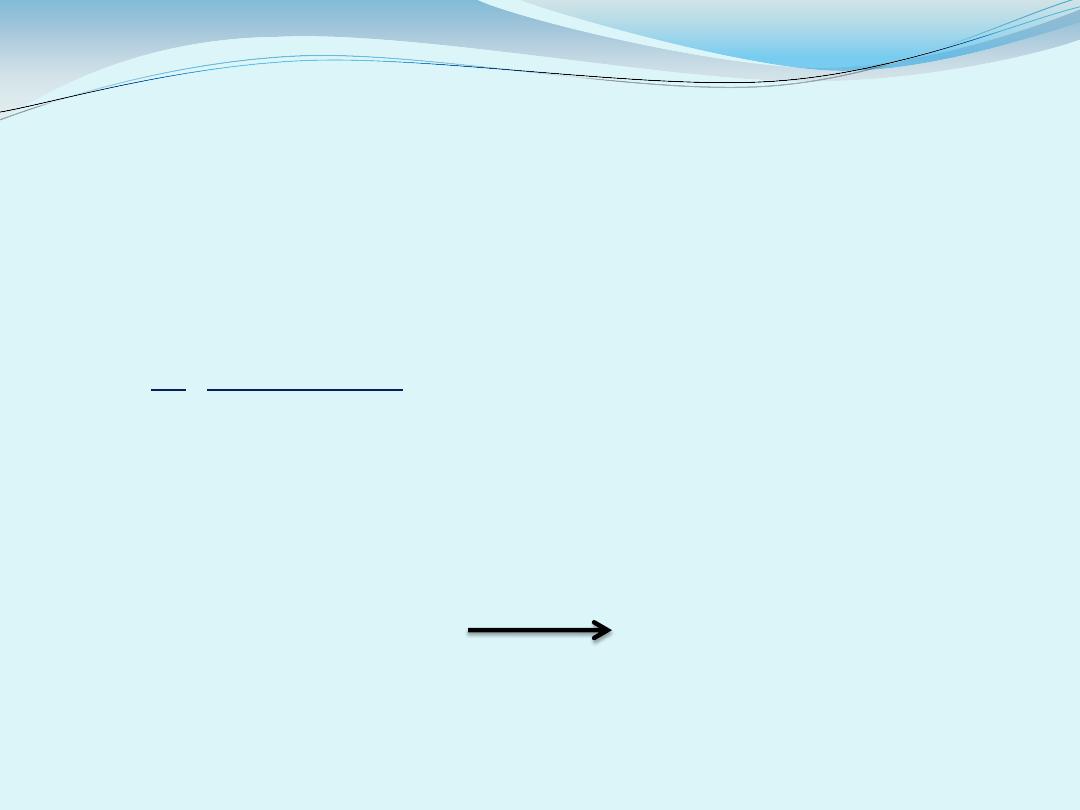
Pathogenesis of malaria
Major clinical manifestation is due to
1- Host inflammatory response which produce chills & fever
2-Anemia due to enormous destruction of RBC
*Severity depends on species of malaria ,most serious
one is P. falciparum
*
the fever in malaria is stimulated by the waste
products of parasites which are released after lyses of
RBSs ,which includs mainly malarial toxins
“hemozoin
or malarial pigments”
into circulation trigger
=TNF
(tumor necrosis factor)
fever

Fever in malaria is
intermittent
P. vivax : benign tertian malaria
48hr P. faiciparum : malignant tertian malaria
P. oval : oval malaria
72hr P. malaria : Quarter malaria

Anemia :-
-Malaria causes destruction both infected & non infected RBCs
-In ability to recycle iron bounded in hemozoin
-Defective bone marrow response
-Spleen removes infected & non infected RBCs from blood ,due
to TNF toxicity
Anemia may cause Juandice

Age
No age limit
Pregnant women and children are most likely to get
it.
People from non-malaria zones are at much higher
risk than natives when they are in malaria zones.

Clinical feature of malaria :-
Incubation period in P. Vivax = 9-12 days (no symptoms)
Then the main clinical manifestation in a typical case of malaria
started which include febrile paroxysms followed by anemia &
splenomeglay
Febrile paroxysms :-
each paroxysms shows 3 stages
1-Cold stages (last 20-60 min. usually 1/2hr)
Chill , felling of intense cold ,although temp. 40˚C ,shivering
2-Hot stages (last 2-4hr)
Fever , 40 -41˚C ,headache ,mild delirium
3-sweating stages (last 2- 3 hr)
Perspiration
The total duration of febrile cycle ≈ 6-8 hr ,these paroxysms
synchronies with the eryth. shizogony
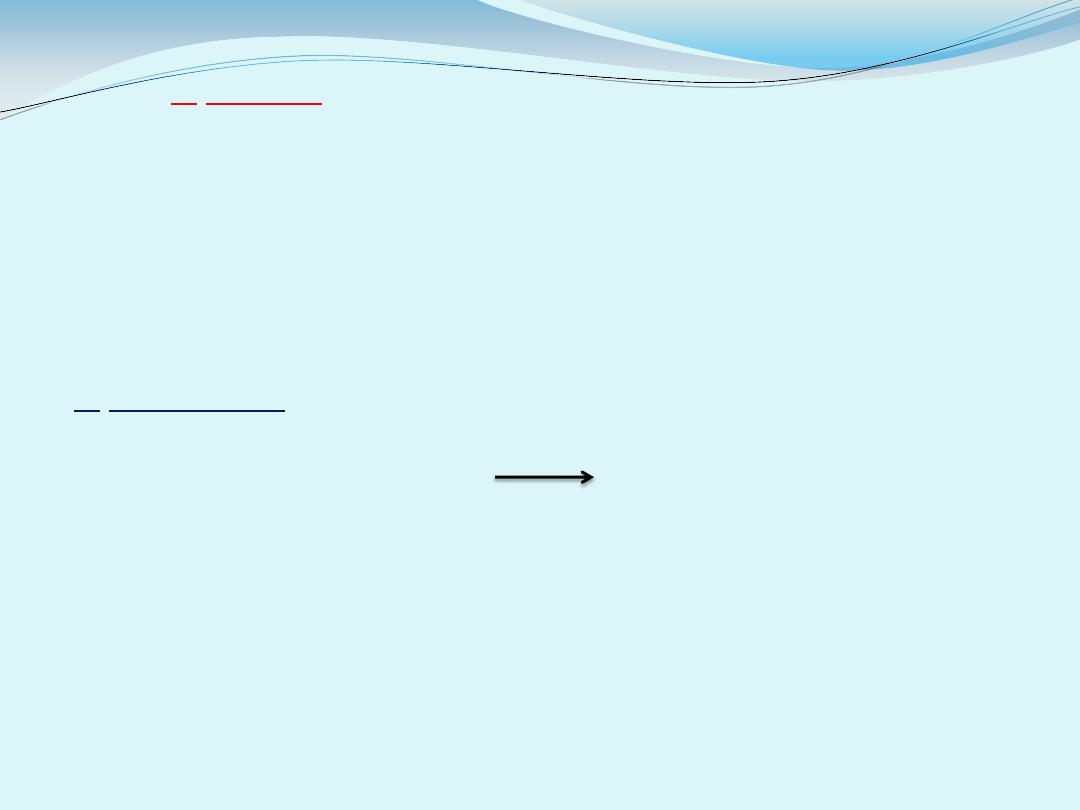
In tertian fever the paroxysms recurs every 48 hr ,while in quarter
malaria (P. malaria )recurs every 72hr ,after rupture of RBCs
When
paroxysm is over after 8hr ,patient feels tired & goes to
sleep for a while ,& then feels fairly well until next paroxysm
Anemia :
after few paroxysms anemia occurs microcytic ,hypo
chronic type
splenomegaly :
.one of important physical sign “spleenic
index”
In P. falciparum there is serious complications due to clotting
of capillary of affected organ circulatory stasis & hypoxia
-Cerebral malaria :(convolution ,coma ,death)
-Pulmonary edema
-Algid malaria: rapid development of shock (adrenal
involvement)
-Septicemia & toxemia
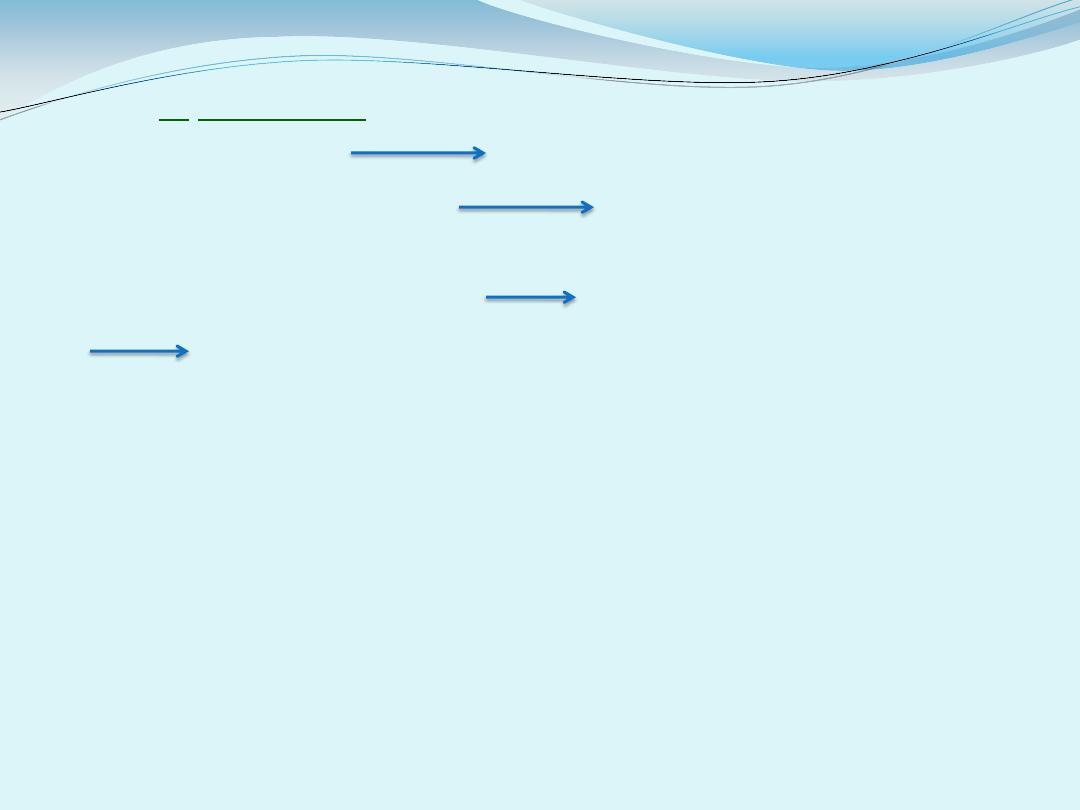
Black water fever :-
Only in P. falciparum
,acute Massive lyses of RBCs ,high level of
Hb & its products renal insufficiently & renal failure
Hb & it’s products in urine dark (black) urine
Usually occur in patient who is taking inadequate or irregular
treatment with quinine drug may produce anti quinine
Ab auto immune hemolytic anemia auto Ab to drug or
to P. Falciparum
Administration of steroids is often helpful in treatment of this
hemolytic crises

Relapse
Back into disease months or years after apparent curve occurs only in
P.Vivax & oval
(activation of hypnozoites in the liver)
may be due to:-
-Lowered Ab titer
-Genetic variation of the parasite
Symptoms of relapse
usually less severe
than the primary attack
Recrudescence:-
In P. malariae ,renewal of clinical manifestation after month& year ,
without re-exposure ,because of
persistence of the parasite
in blood at
too low level to be detected & produce symptoms ,such parasitemia
persist for years until sudden increase malarial symptoms
In P. falciparum ,if the patient survive remission naturally or with
treatment the parasite completely disappear from the blood cure

Each disease has a distinct course
P.ovale and P.vivax
can cause chronic malaria
,
reappearing after months or years
due to latent parasites in liver

Diagnosis of malaria :-
-Depend to some extent on clinical manifestation of the disease
-Demonstration of the parasite on stained smears of the
peripheral blood
Microscopically examination of blood film is the most
important diagnostic procedures
thin for species identification
thick for quick diagnosis
Blood film done :
Just before or at beginning of paroxysms
-Visualizing the parasite after staining by fluorescent dye
-PCR
-Dip-stick method for detection of material Ag
-Serological tests C.F.T. precipitation test
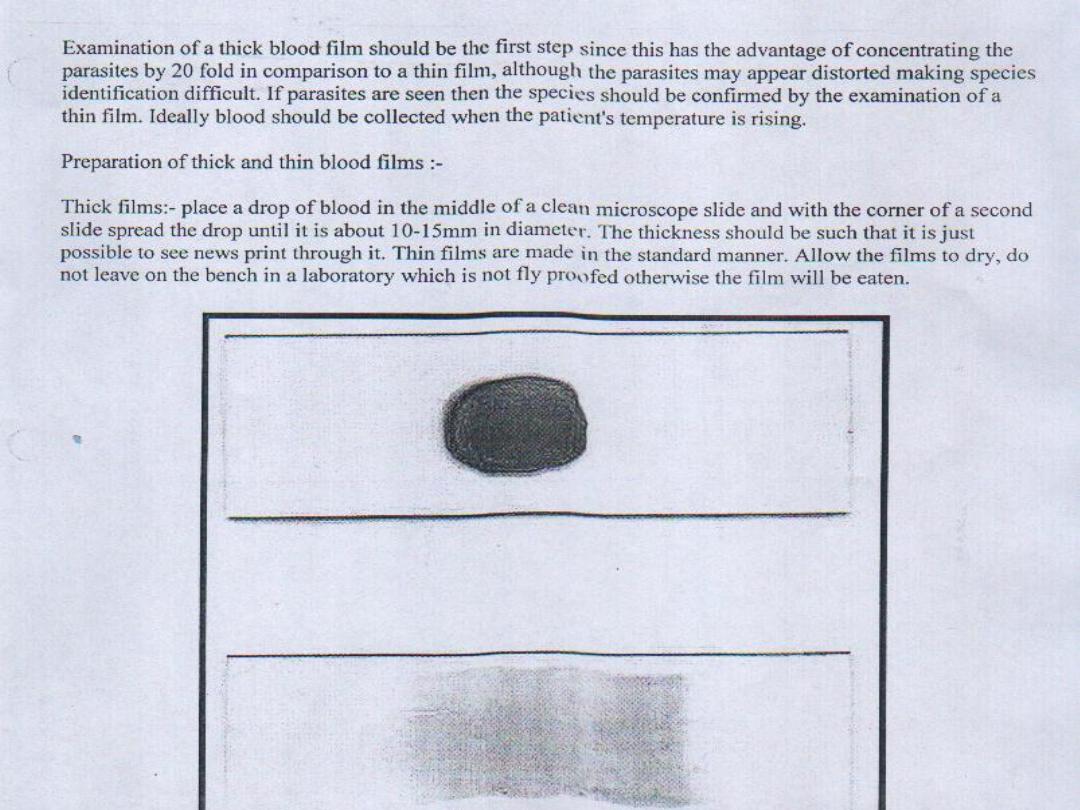

Immunity to malaria is specific ,strain & variant specific
Genetic resistance to malaria
1-Black people (Duffy blood group) natural resistance to P. vivax
2-Sickle cell anemia
fauvism Abnormal Hb
Thalassemia
Treatment of malaria :-
Anti malarial drugs
Alkaloid :quinine ,chloroquine ,primequine
Chloroquine prevent digestion of Hb so no hemozoin ,it is not
effective in exo-eryth. schizgony
primequine kill hypnozoint so prevent relapse
In resistant malaria :mefloquine , fansidar
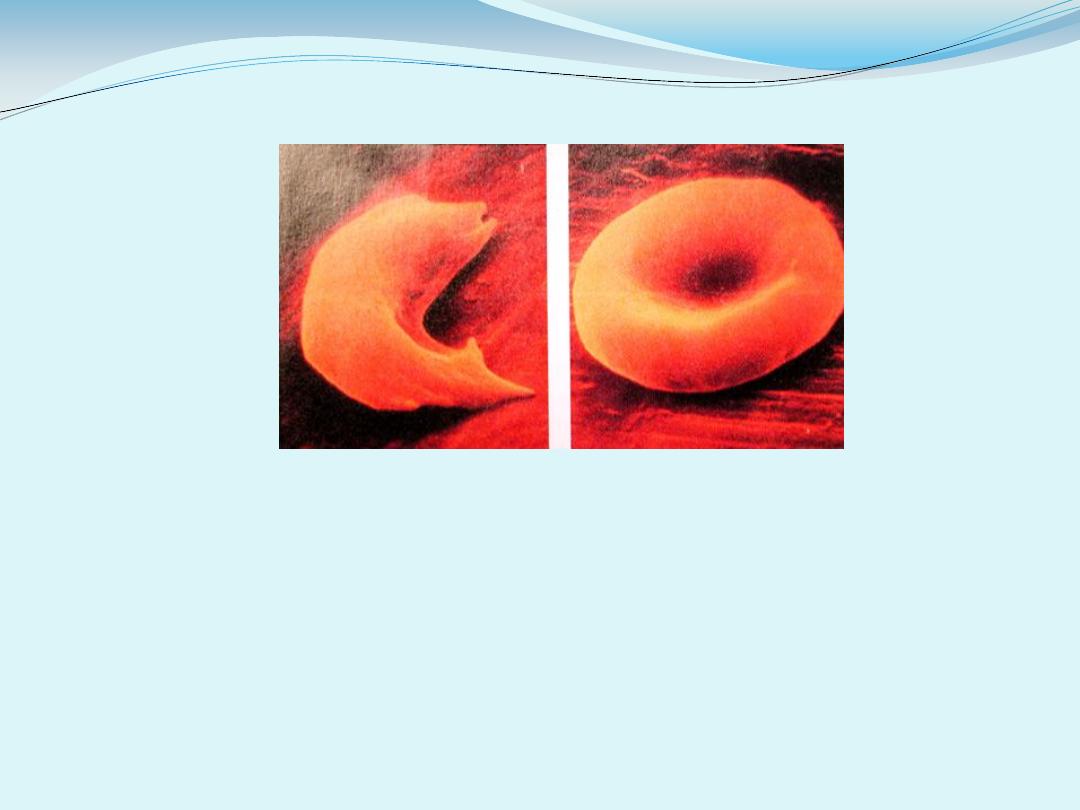
Genetic
Resistance
Sickle celled anemia
Codominant trait (Allele “A” and “B”)
AA have sickle celled anemia
AB have both types of cells
Sickle cells don’t support species of Plasmodium well.
Resistance to infection

Prophylaxis :-
Vaccine :difficult (different stages ,changing their Ag )
Travelers to endemic take chloroquine 2 weeks before &
contain to 6 weeks after leaving ,followed 2 weeks primequine
Control :-
Mosquito control (netting ,window screen ,destruction area of
mosquito life cycle using predators (fishes) insecticides DDT
Drug resistance malaria & mosquito resistance so malaria will be
with us as long in there is people
